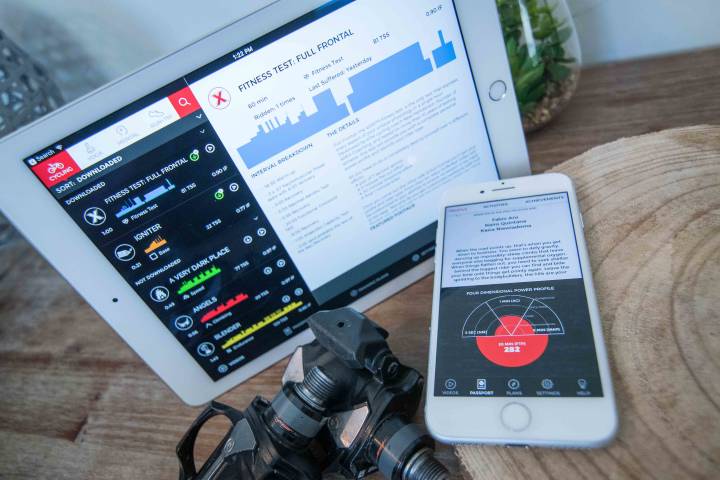
Earlier this week The Sufferfest rolled out a pretty significant change to its indoor trainer app. The platform has been around for a number of years, but has really honed its focus in the last 1-2 years and reinvented itself. In doing so it’s become quite a competitive indoor option to leading apps like TrainerRoad and Zwift.
The main change was shifting to something they call ‘4DP’ – for Four Dimensional Power – which essentially defines your cycling power profile into buckets. This 4DP profile is generated after you complete a 60 minutes of fun called the ‘Full Frontal’ test. All of which is then used with their included training plans and videos to give you more specific targets for workouts. Said differently, it’s becoming more like a coach than just an app with exciting videos and workout targets.
Oh, and before we get too far along, I totally get that The Sufferfest gets all bent out of shape when it’s shortened to Sufferfest (sans ‘The’), but because I think writing The Sufferfest over and over again is annoyingly pretentious (like saying ‘The DC Rainmaker” or “The Google”), I’m shortening it to just ‘Sufferfest’ for the remainder of this post. With that, let’s get started.
The General Concept:
Now, there’s a lot of concepts behind the whole 4DP thing, as well as some marketing claims made. I’m going to attempt to step through many of them. First, one of the biggest claims is ‘FTP is dead’. Once you get past the marketing hyperbole there in that statement, the underlying concept (as they detail at length in numerous posts/videos), is simply that one single number (your FTP) can’t define you as a cyclist. Remember, FTP is generally defined as your peak power output for roughly one hour. There are different ways to test it, but like politics, everyone thinks their way is best.
Now, while the ‘FTP is dead’ notion may sound like hyperbole, many platforms already agree with this. Various companies and entities have been doing bucketization for quite some time. Some automated, some manual. For example, we saw Xert do this within their training platform, and WKO4 within theirs. Coaches and organizations have been doing this type of stuff for years as well. Sufferfest notes their work is driven by Apex Coaching, a well known/respected firm that’s produced a number of Olympians.
Anyway, back to the 4DP part. The 4DP refers to these four specific power profiles, which they discuss in more detail in this video:
As you can see above in my awesomely created animated GIF, the different buckets are formed from specific max powers for given timeframes within this single test. For example, if you’re a triathlete, you probably don’t train/focus as much on sprint power, and thus, your numbers will be lower in something like the neuromuscular power bucket.
The point of all this is that each cyclist tends to have different things they’re good at (or can improve). Using a single number that’s basically how long you can hold wattage for an hour doesn’t translate as well as multiple data points. And the industry has largely agreed here for a while. But to say FTP is dead? Well, that’s a stretch – since the Full Frontal test still includes an FTP test within it, and one of the four buckets is very much still labeled FTP. I suppose “Using FTP as a number is less important now, but not dead yet!” or “FTP is dead and we used the carcass inside of 4DP as a data point” isn’t exactly a super sexy marketing slogan.
Their goal is to show that two people can have the same FTP, yet vastly different power profiles. And tons of past research by many people agrees with this.
But I think a lot of conversation I’ve seen online about 4DP has glossed over the really important part: This goal here isn’t just to find a set of numbers that define you (a new FTP-like thing if you will). The whole point of 4DP and what Sufferfest is doing is to then give you very specific guidance for your training. Actual workouts with an actual training plan, based on these data points.
And that’s super critical to understand. There are analysis apps (e.g. TrainingPeaks, Today’s Plan, Xert, WKO4, SportTracks, Strava, Golden Cheetah, etc…), and then there are core trainer apps (e.g. TrainerRoad, Sufferfest, Zwift, Kinomap, etc…). Some of these apps even cross, such as Xert, which does have a trainer app aspect to it (which is quite advanced). The same with Golden Cheetah.
But wait – I’m not done yet. Within any of these apps there are then some apps that provide specific coaching-style recommendations, plans, and workouts. For example, TrainerRoad has workouts and plans and can determine your FTP. As can Zwift. Can they do it in a multi-level way like Sufferfest and Xert does? No, not today, and that’s fine. They are adding value in other ways that many feel is more beneficial to them. In Zwift it’s the entertainment/race factor, and in TrainerRoad it’s likely the library of workouts and depth of devices/sensors they support. Meanwhile, almost none of the analytics apps offer any sort of training plans.
Oh, speaking of devices, before I start the test, note that Sufferfest currently runs on iOS, Windows, and Mac. No Android today. Which, makes it just like Zwift (for the time being).
Doing the test:
In order to get 4DP data, you have to do their Full Frontal Test. You can’t simply input your own max power numbers for 5s/1m/5m/20m. The overall test takes 1 hour long, and includes four sub-tests, one of which you do twice. These are, in order:
A) 5 Second Test
B) 5 Second Test Again
C) 5 Minute Test
D) 20 Minute Test
E) 1 Minute Test
The goal for all of these tests is painfully simple: Go as hard as you can for that period of time. The reason they give you the 5-second test twice is more about figuring out the logistics of it than anything else. They just take the highest of the two values.
I should point out that they have an entire video on how to prepare for this test, including what to do in the week beforehand to prepare. I ignored all of this advice and trained normally. In fact, I didn’t even decide to do this test until eating cereal yesterday morning. 90 minutes later, I was on the bike. My preparation game was strong!
To start things, I connected my iPad to my trainer and HR strap. I decided to use the Tacx Neo and the Wahoo TICKR-X HR strap.
Next, it’ll ask you to confirm your trainer is in standard/level mode, not ERG mode. This is because you need to be controlling your power for this test, as opposed to the trainer doing it for you.
From here you’ll go through a bit of a warm-up, as well as an explainer of what’s to come. Note again, the term FTP test is included here. Thus, it’s not dead yet.
Here’s the overview of what’ll happen:
The app will count-down to the start of all sections, as well as give you specific guidance on what to do during that section. You’ll see that red bar at the top there, which is the count-down timer. It’ll show the actual minutes/seconds left occasionally, but otherwise just leave the red bar.
Along the very top you’ve got your current cadence/HR/power numbers in big text, and then the little text is your targets. Note that if you had an FTP specified in the app previously, it uses that for all targets for this test, though it does warn you to just use that as a suggested guide, and not a hard/fast rule.
In the case of the 5 second max sprints (which are 7 seconds of timed duration in the app), you’ll probably get a bit better on it the second time around. Figuring out your cadence and gearing to nail just those seconds is a bit tricky, and is different on every trainer (in terms of how it spins up).
You can see here on the screen my targets and current wattages for the 5-minute section.
(Fun side note: There was approximately a 15w difference (at 300w) during the test between my power meters and the Neo, with the Neo reporting lower. Whereas the FTP number I had set was assuming a power meter number. So, I had to mentally adjust to the Neo number. Or inversely, my Sufferfest numbers will look 15w or so lower than reality.)
After the 5-minute test (which follows the 5-second tests), it actually tells you to go for a short walk for a minute or so.
Soon after that the real suck starts, which is the 20-minute test. It gives you some suggested text on what to target:
The problem with the above text is that it’s not super helpful. Since they don’t actually show you the average power mid-ride for your test sections, I had no specific idea what that 5-minute test ended up at. Was it 350w? 360w? 380w? I was floating in that region.
Why not just simply show that on this screen, like this:
“Otherwise, you should be at about 80% of what you rode during those five minutes: 80% of 355w = 284w”
No reason to play guessing games here when my brain is operating on limited blood flow. Instead, it just showed my manual FTP number from before (315w, from a power meter, not Neo).
In any case, off to start my test I did. Here’s the count-down timer for the last 57 seconds:
After finishing all that fun, you have a short recovery again before starting the 1-minute test:
And then a short bit later, I’m done:
Upon completing the test it’ll first show you the standard ride completion screen. It’s this screen that allows you to automatically upload to Strava, TrainingPeaks, Garmin Connect, and shoot an e-mail with the file. Here’s mine on Strava from yesterday.
Then from there it loads up your 4DP profile data, which is a great time to start the next section of this post.
The Results:
Once completed, the full frontal test results are available within your ‘Activities’ page under the passport. You’ll see the various max power levels that you hit for 5-second/1-minute/5-minute/20-minute power:
It’ll also specify your lactate threshold heart rate, and then below that you’ve got various graphs from the test:
Meanwhile, if you tap on the ‘Profile’ tab, you’ll see your new 4DP profile data. On the left side is your ride type (climber in my case), and on the right side you’ve got how you rank for different categories.
I can then scroll down and it’ll suggest a primary area for improvement, and then specific workouts that I can leverage to improve those areas. The production app had a bug for my rider type where this showed blank for me, so they sent over two screenshots using my profile on the latest beta build:
Then a second section shows additional workouts you can use to improve your strengths:
So what happens next?
Well, depends on what you want. You can go into their training plans, which are included, and then just cook away on whatever multi-week plan you want:
The only downside here is that none of these plans are electronically in the app. Instead, it’s a PDF schedule that correlates to workouts in the app. So you can’t just open the app and have the correct workout for the day listed. The company says that’s on the radar, but for now it’s kinda clunky. On the flip-side, the PDF’s are incredibly detailed, just like a coach would give you. So that is positive.
Next, any workouts within the app will no longer use the FTP number, but instead your new 4DP number. This means it’ll change intensities based on 4DP instead of FTP. You can toggle in the settings to see these differences, for example, here’s how The Shovel workout looks comparing the two side by side:
Note the look of the ‘bell curve’ on that first chunk, and how for my 4DP profile, it’s got less super-high sprints, and a bit more meat lower instead. I still hit the high wattages, just not as much as if I was using the straight FTP number.
This concept carries through the rest of the workouts as well. Note that each workout has a specific focus, and is shown according to a set of stars:
And again, as is probably obvious by now – only Xert to my knowledge is doing any sort of live/reactive shifting of structured workouts automatically based on the test data, beyond just the FTP value. Hence, the main value of 4DP here for folks without a coach.
The core difference though between Xert and Sufferfest in relation to that then is that Xert is doing this both live mid-workout based on your ability to hit targets, as well as updating your power profile after every ride (both inside and out). Whereas Sufferfest only accounts for things in the app, and only based on the test. Inversely of course, Xert lacks any of the motivating and entertaining videos that Sufferfest has.
Oh, and yoga:
What’s funny about most cycling apps is that they attempt to be coaches without being a coach. Which is to say that most really good coaches will give guidance in other areas of your athletic journey aside from just the timed structured workout. For example, my coach would/will give me some prescriptive guidance on various core and stretching exercises I should be doing, as well as nutritional tidbits, primarily related to race day or long training days.
He isn’t trying to be a nutritionist or Cirque du Soleil coach, but he is imparting some useful knowledge that I may not be aware of.
And in a sense, that’s what Sufferfest is trying to do on the whole here – replicate parts of a coach. And one part that most endurance athletes screw up is flexibility and core strength. Which isn’t that we don’t know it’s important. We do. It’s just that we never usually fit it in. Sufferfest is aiming to address that gap by appending it to workouts in short bite-sized pieces. They know that if it’s ‘only 5 minutes’ to complete a quick yoga session, or 15 minutes to do some core strength, you’re likely to do it. Versus a larger 30-40 minute routine, where it’s unlikely you’ll complete it.
After my 4DP test, I did one quick meditation session. Mostly because the session involved lying on the ground and staring at the ceiling. Which seemed perfect, given the situation.
Afterwards, you can upload the session to any of the connected platforms like before, except that it doesn’t record any sensor (HR) data.
In addition, the company is also doing mental conditioning related exercises. These are a set of videos (really just audio, as far as I can tell), but have incredibly detailed workbooks alongside of them.
For those that want to tap into it, it’s definitely unique in this segment and again goes a ways towards trying to give people things that coaches might provide (but that many people can’t afford).
As an aside, I’ve been long meaning to read ‘The Brave Athlete: Calm the F*ck Down’; one of these days I will (I bought it on Kindle already…it’s just…well…waiting for me).
Wrapping up:
Now, power meter training veterans will likely say that what Sufferfest is doing isn’t anything different than what came before them. Or that they’re using others’ work. And there are elements of that which are true. But it’s also true to say that anyone in the sports field is using the work of those that came before them; it’s building blocks. It’s not much different than Boeing not mentioning the Wright Brothers on every marketing slide.
More importantly though, there are core differences between what Sufferfest is doing and others. Those differences may not matter to some people, whereas they may make all the difference to others. For example, if you’re fine reading through hundreds of pages of power training literature, or if you can work magic in various analytics suites – then yes, you can largely do this same thing as Sufferfest in terms of the 4DP portions (obviously the app and videos are still huge).
But if you can’t (and the reality is, most people can’t or don’t want to), that’s the gap Sufferfest is trying to fill. They’re trying to elevate the discussion for the majority of people from a simple number (FTP), to a more personalized set of guidance. In other words, they’re trying to be your coach. Because (and this is the important part some detractors forget), that’s exactly what your coach is doing.
Your coach (if you have one) is taking data in about you, and prescribing workouts on what is hopefully a more personalized level than just FTP. They’re looking at your specific goals and your various power profiles, and generating something personalized. Just like Sufferfest.
Of course, from an automated prescription and analysis standpoint, Sufferfest isn’t entirely first here. Xert started doing elements of this earlier this year, such as categorization and smart real-time adapting workouts that leveraged current numbers. But Sufferfest has seemingly taken it a bit further with entire plans and more custom tailoring (again, like a coach would do).
All of which is different than TrainerRoad and Zwift, which are more static in their approach to training plans. They assume a specific input number (FTP) and then base workouts and training plans from that. Of course, that approach has worked well for years, and both those applications have other selling points too.
But ultimately there’s sorta a hidden secret here: For the majority of the population, you’re going to get faster with almost any well laid out and structured training plan, which all these companies give you. If you find a specific app that works better for you because you enjoy using it, then it’s likely you’ll see gains with that app and its structure.
With that, thanks for reading.
—
Preemptive unique warning: Like any of the other 2,659 posts here on DCR, it’s all about a civil discussion in the comments section. Insults, attacks, and anything of the sort will not be tolerated. I will be zapping non-constructive posts instantly, regardless of how important you think you are. You can have a difference of opinion on any topic you want here, just don’t be a dick about it. Got it? Good. Enjoy, go forth, and discuss!
FOUND THIS POST USEFUL? SUPPORT THE SITE!
Hopefully, you found this post useful. The website is really a labor of love, so please consider becoming a DC RAINMAKER Supporter. This gets you an ad-free experience, and access to our (mostly) bi-monthly behind-the-scenes video series of “Shed Talkin’”.
Support DCRainMaker - Shop on Amazon
Otherwise, perhaps consider using the below link if shopping on Amazon. As an Amazon Associate, I earn from qualifying purchases. It doesn’t cost you anything extra, but your purchases help support this website a lot. It could simply be buying toilet paper, or this pizza oven we use and love.

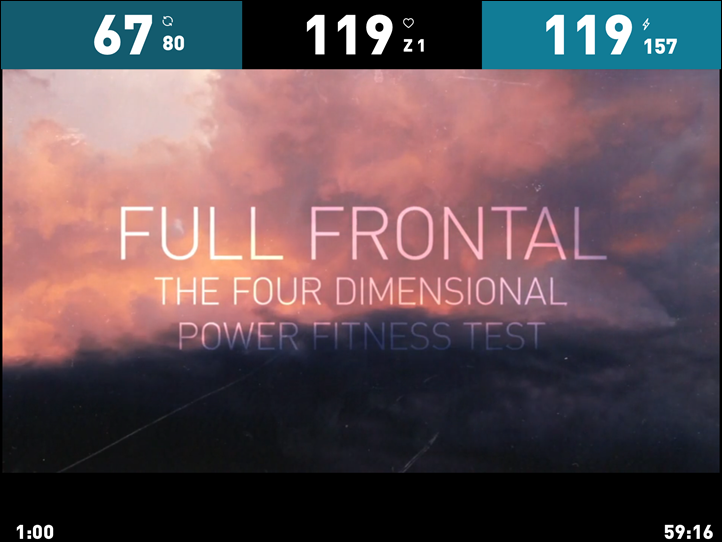
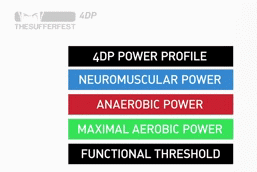


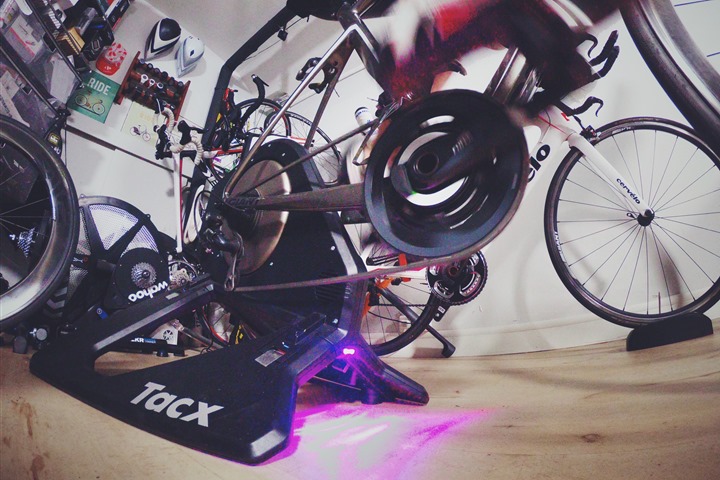
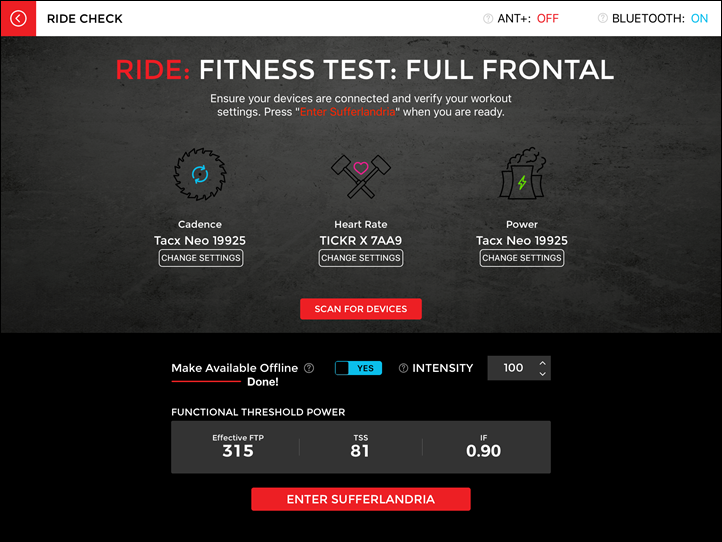

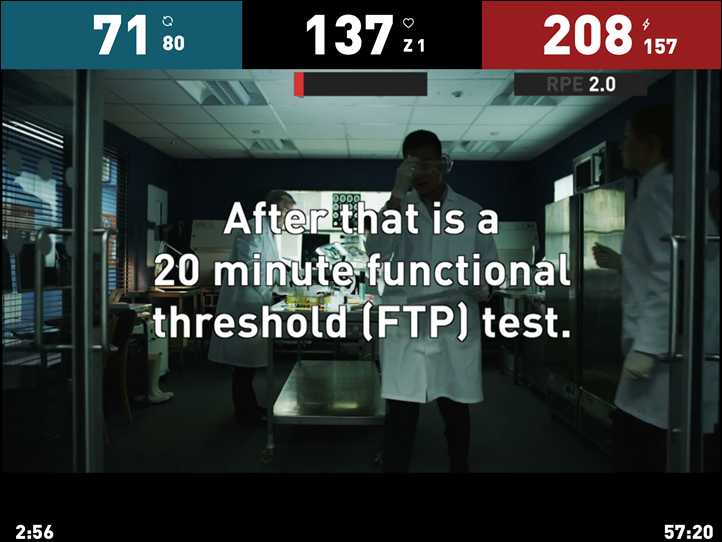
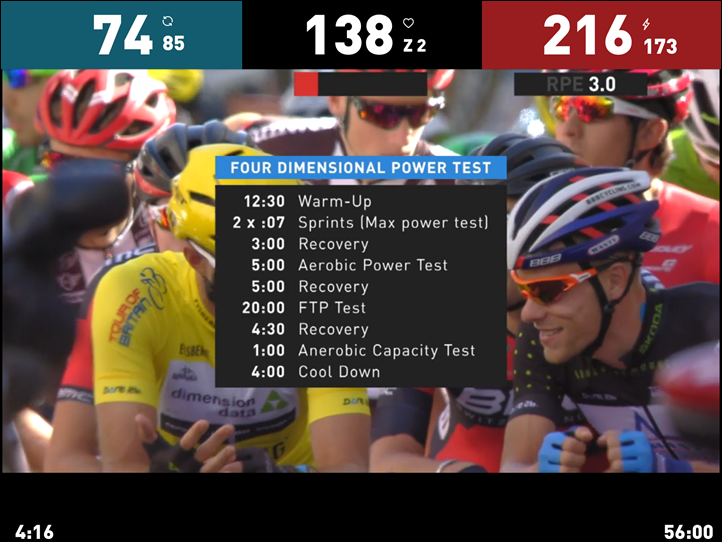
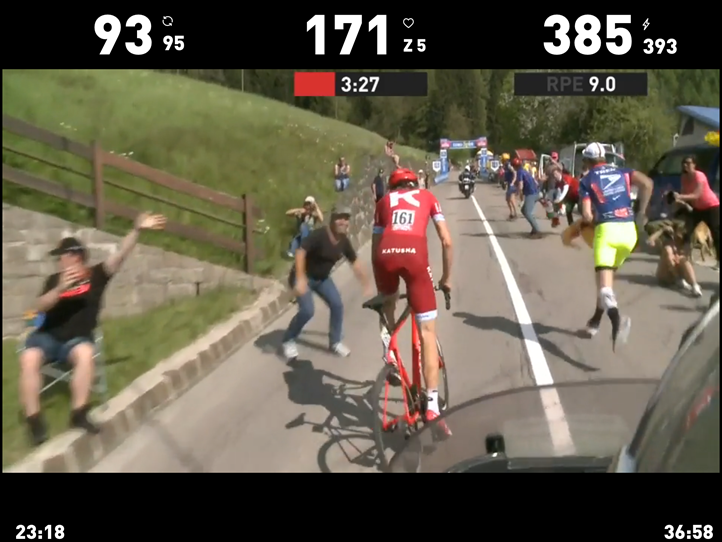

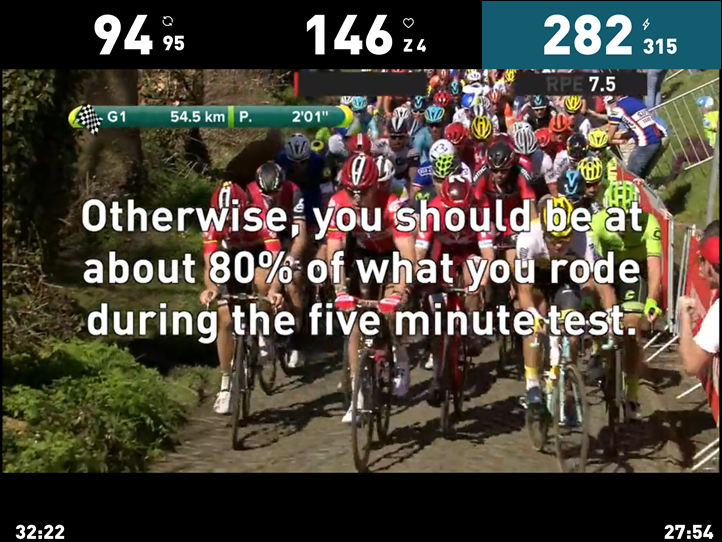
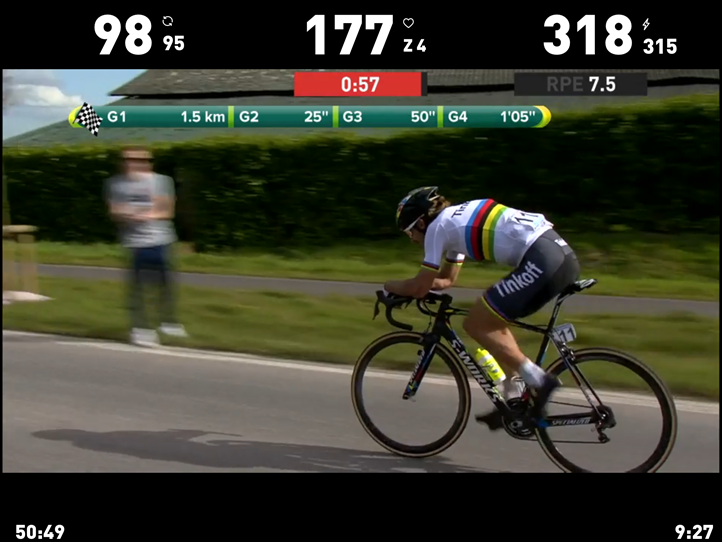
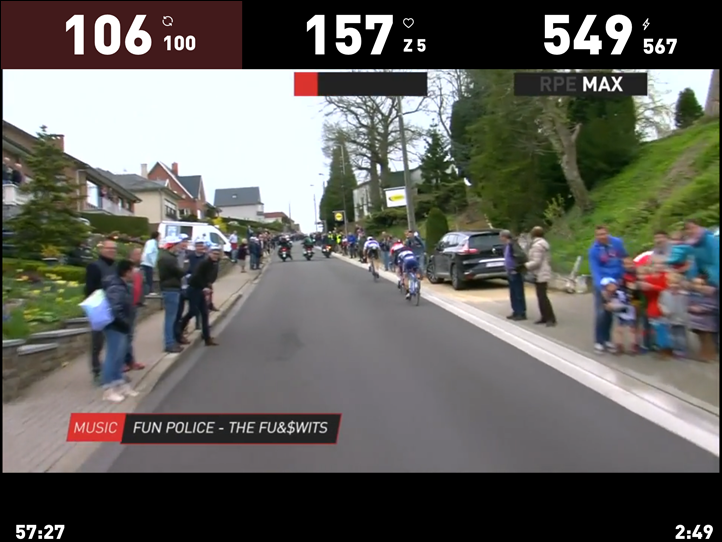
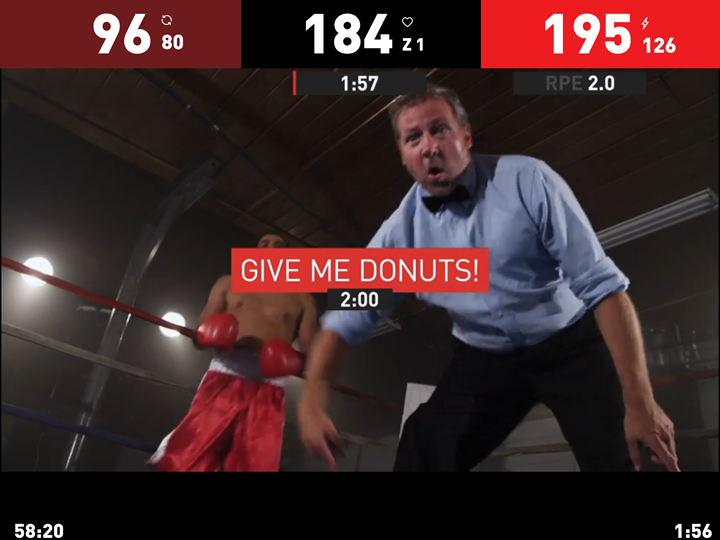
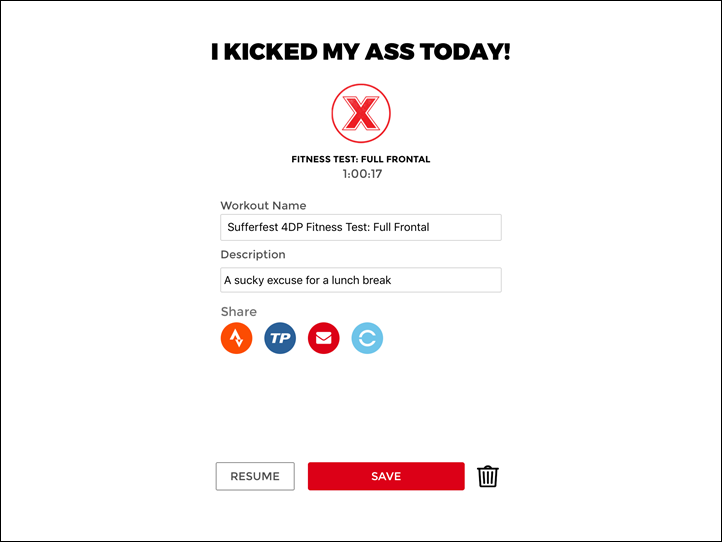
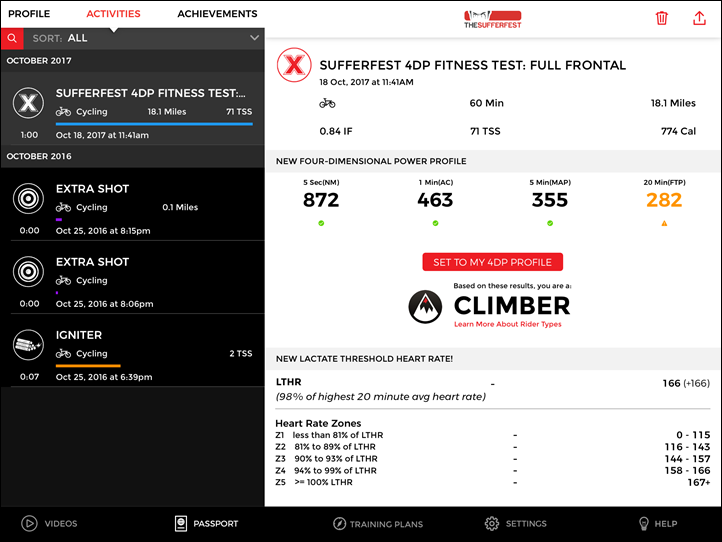
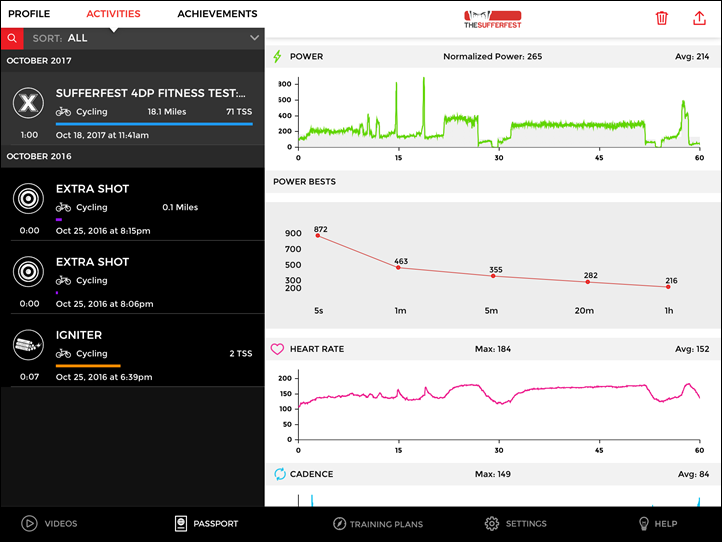
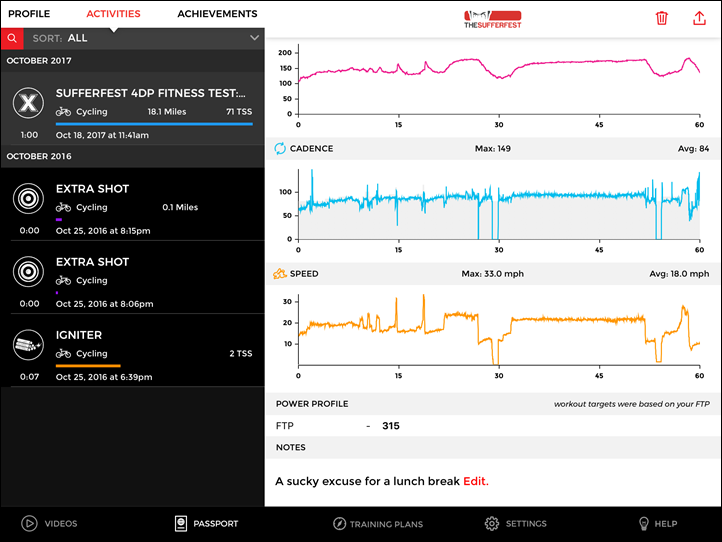
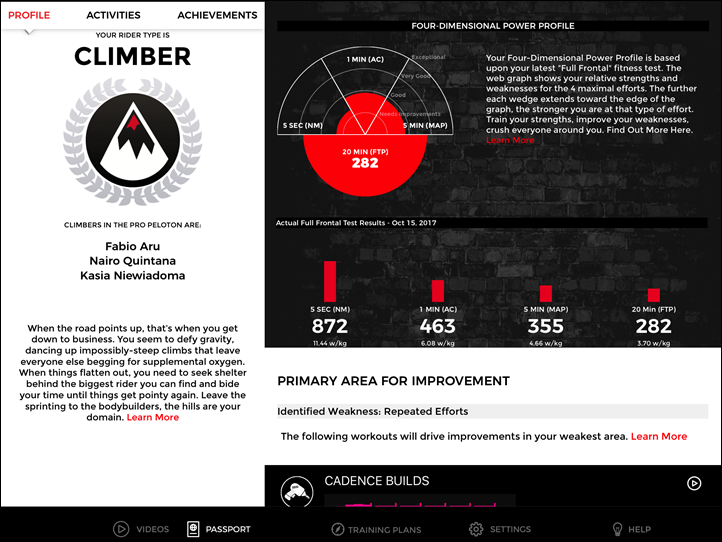
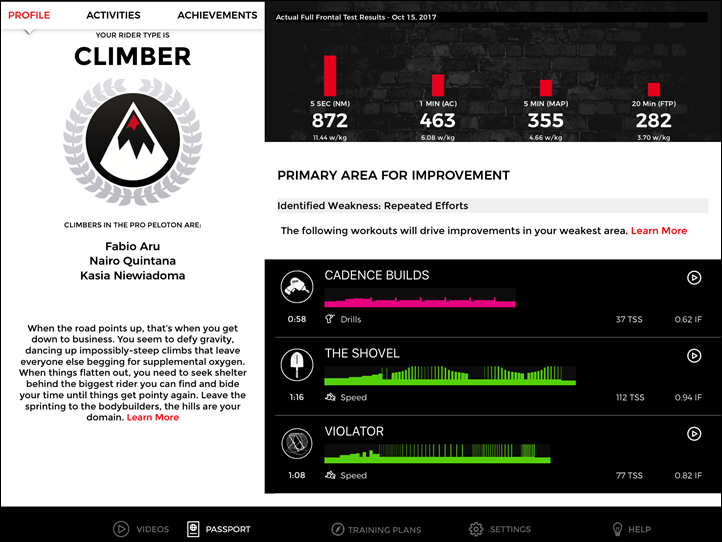
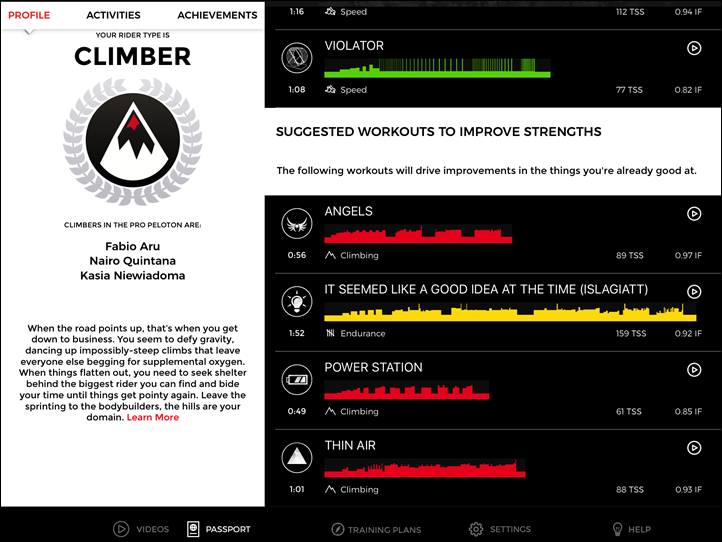
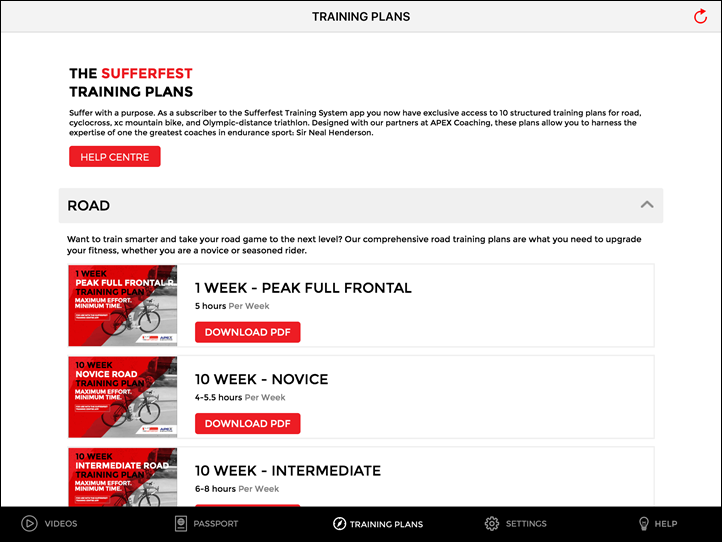

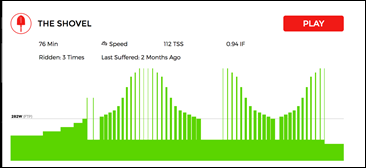
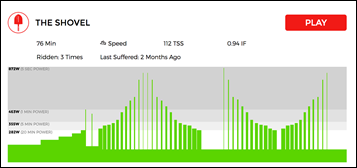
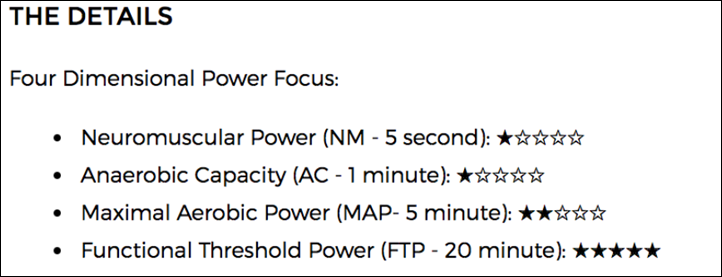
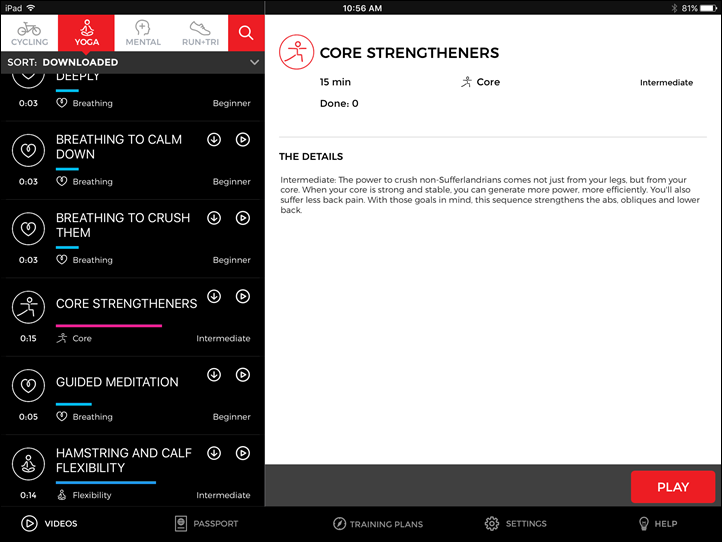
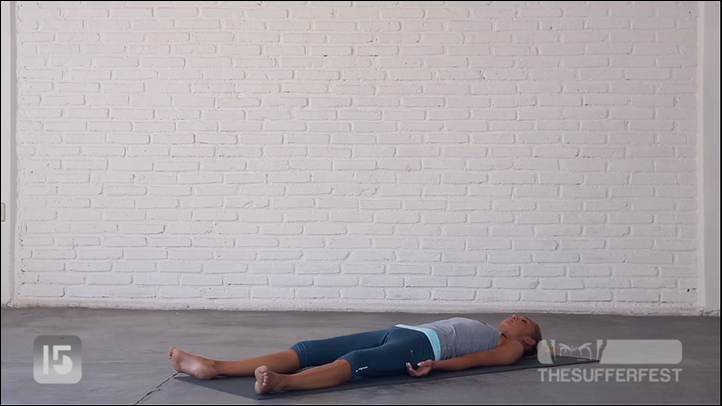

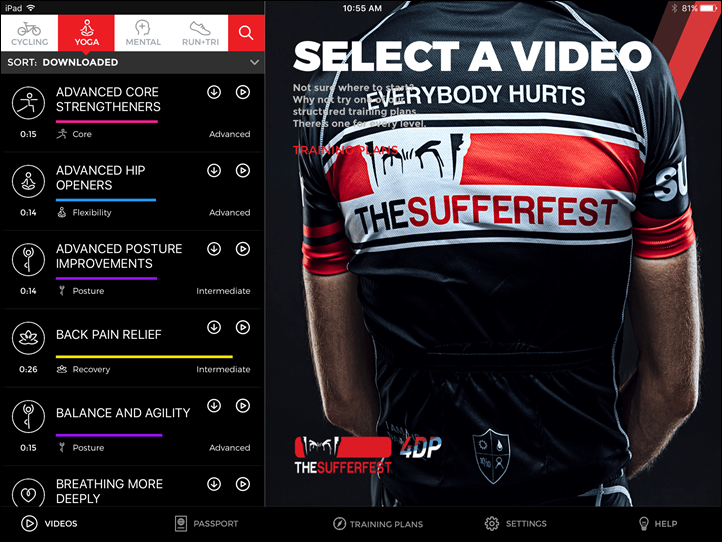

















Hi Ray,
thanks for not answering my e-mail and writing a decent blog post instead! :-)
(note to myself: be a bit more patient next time)
I’d be keen to use the app if only they would implement a power match feature, to have some consistency across indoors and outdoors. I’m the mean time I’ll stick to TR…
Not a complete blocker for me, but this was one of the reasons I decided to let my subscription lapse. Will try FullFrontal on a free trial though, intrigued what it will show :) Really like the way the app is going since it was introduced.
I think that I’ve seen a longer than 7 day trial (which is the typical, I think). Good opportunity to try 4DP and explore the videos (and other features) a bit.
There was one for this release, promo code RIPFTP, where the first month was free when you signed up but believe that closed on the 13th October. Might be others though..
Two things that are really disappointing about the app:
1. Lack of power match. Given the way the videos put you right on the razor’s edge, a 10w difference in average power can be the difference between finishing or not finishing a particular interval. Really don’t see the down side of implementing this; TR has had it forever.
2. Lack of calibration in desktop app. Until power match shows up, the desktop app should have calibration available. You should be able to do 5 minutes of the wko (usually not the most critical portion), do a quick spindown, and then continue without having to turn over control of the trainer to another application. (Or hell, have a “spindown” video of 7 minutes to use before starting).
(Setup: kickr snap; ptap c1.).
If you use the Full Frontal test to determine your 4DP using your trainer’s power meter, then wouldn’t power match be unnecessary since the workouts would be using the same power data? Is it just a mental thing that you know your power is 10W higher when using your ptap c1 and so you want to use that in the program so you get to see that higher number, even though in theory the resistance felt during the workouts would be the same, since the workouts will be relative to the 4DP test results.
The problem is that it assumes a constant mismatch between powermeter data and trainer data across the full range of power values and conditions.
As someone who DOESN’T have a smart trainer but does ride indoors a lot with a powermeter (on v-arion rollers) I gets different zero-offset calibrations with my P1 pedals each day.
I zero offset each ride and within a ride if I’m about to do an FTP test. That way I trust the numbers and they cross over between indoors & outdoors no problem.
I love the ‘Fest, but I’m bummed that there seems to be a intrinsic flaw in power meter & data handling that will seriously affect the results of the 4DP test and the training targets it generates.
Hey Angus – Just re-posting the comment from our head of technology, Reid Weber, from another comment thread in case you missed it: “What we recommend is people use the manufacturer app for their trainer to calibrate the trainers or a bike computer for power meters to calibrate them. We initially added spindown for Kickrs in our iOS app and tried for FE-C, too, but the process for each trainer is different and some don’t need it like the Neo and Elite Directo so we didn’t even try to add it to our desktop app. Zero calibration wouldn’t technically be that hard to add but I think a lot of power meters handle this automatically now anyway.”
I’d love to see a power match feature too. I get lots of dropouts from my Kickr, but very few from my Vector2 pedals. Support just blamed it on WiFi interference from my nearby router. Don’t have the same degree, if any, issues with TrainerRoad.
I have enjoyed using the app for the yoga sessions. They have helped keep me healthy for training and the 15 minutes or less has made it motivating to do right after workouts.
The Mental Training Programme is also really well done. The audio sessions and workbook are well developed and can get you thinking about some things in detail that you may normally end up overlooking.
At this point the bike videos/app workouts are a bonus for me and not the main reason t have the app.
Hey Barry – So great to hear you’re enjoying the Yoga from Abi Carver and our Mental Training Programme. Together with the cycling and running workouts, as well as all the training plans, it’s our goal to help you become the most complete — and best — athlete you can be. Sorry to hear you had trouble with the dropouts — I’ll also check with the team on what might have caused that.
I had loads of dropouts on my kickr. Seems to have been light interference (flywheel turning triggers optical sensor, sensitive to bright or low light, for me sunlight probably through moving leaves or reflecting off pool fouled it up). All better after using a towel to cast a shadow. Another issue was conflicting apps – make sure wahoo tools or wahoo fitness on your phone or tablet aren’t competing with your laptop for the same signal.
I think this looks excellent, and will certainly give it a go – as you say, the package as a whole really seems to move the training-app landscape onward.
I was planning on getting Zwift and probably a coach. I reckon this is well worth a try over winter instead.
(your pre-emptive warning piqued my interest a bit… Certainly some heated discussions going on!)
Thanks, Portemat! Hope you are suitably enterPAINed. Be sure to check out the full suite of things offered in the app — it’s far more than just cycling workouts.
I love sufferfest but for me bluetooth control of smart trainers (Tacx) is a must so I had to ditch it…
bluetooth control via iPad app seems not so difficult but they don’t want to implement it.. :(
I’ll keep with trainerroad looking at their website every week hoping to see if they changed that :)
We’re working on it. :)
Really? The site and iOS app description explicitly says that BT4.0 is supported. But only to read from the trainer, but no ERG mode? A bit of a miss for the workouts where it is best if the trainer enforces wattage.
Ah, OK. Will wait subscribing for the free trial when this is done.
trying error:
“Earlier this week The Sufferfest rolled out a pretty significant chance” -> … “change”
“doing any soft of” —> “sort”
Thanks (and a few others too!).
I was a beta tester for the app, and can’t say enough good things about Sufferfest and 4DP! The value this approach represents for amateur triathletes like myself is HUGE. There are tons of $100+/mo triathlete coaches around who aren’t worth anything, and I can’t afford an elite coach. For only $10/mo Sufferfest generates personalized workouts (workouts and personalization designed by elite coaches Neal Henderson and Mac Cassin of APEX Coaching!) for me just like a $500/mo coach would. As my 70.3 podium finishes this year can attest, it works. It’s fun, and it will help make you faster than you thought you could be.
When you add in that all the workouts have killer videos, that the app contains yoga and running videos too, training plans, a nutrition guide, a mental training plan, and an awesome world-wide community (with a National Tour and other events!), Sufferfest is definitely one of the best investments I’ve made.
Since you’re in shill mode, curious which 70.3’s you podium’d at? Had you done the races prior with same/different results?
That’s not very nice, but I take your point. I’m just a big fan of Sufferfest and am excited to see this get rolled out to everyone. I placed 2nd in my age group at both the TriFtWorth and the Kerrville 70.3. I’ve done other 70.3s with different results, yes. The most noticeable difference for me was being able to maintain higher power output on the bike for the same level of effort.
Good to see some independent Half Distance races and that you supported them by racing them. However, judging by your times I think you (and most of us) would fall into the note Ray made at the end–if the Sufferfest app is what you enjoy using and gets you on the trainer more, then you’re going to see improvements just like any other.
“For the majority of the population, you’re going to get faster with almost any well laid out and structured training plan, which all these companies give you. If you find a specific app that works better for you because you enjoy using it, then it’s likely you’ll see gains with that app and its structure.”
So the workouts that “The” Sufferfest provides includes workouts for swimming and running too? I didn’t catch that in the review, but if you attribute the podium award to this app, I would assume you had some structured swim/run workouts too.
Yep, they have running workouts, brick workouts and a triathlon training plan all included in the app. Good value for money.
What’s wrong with my times? I might not be the fastest out there, but I’m faster than I was when I started, and I’m proud of the improvements I’ve made.
You want to hate on me because I worked hard and improved using a “well laid out and structured” training system I enjoyed? It isn’t your place to judge me or my performance.
You should be proud of making improvements, that’s what we all aim to achieve. However, your times *ARE* slow for a typical 70.3 podium finisher in your age group (probably need to knock an hour off your times at a larger/deeper race), yet you brandished your podium placements as evidence as to how the app made it possible for you to get there–that’s what I’m “hating” on, I guess. Anyway, I’m just being prickly this morning. KCCO
No question that I’m not going to take the podium a big Ironman 70.3, I get that. Maybe you take 1st place every time and it’s no big deal to you, but it was a big deal to me. I hope you’re at least satisfied that I’m not a liar.
Regardless of what place I finished, I made a lot of improvements this year of which I am very proud, and I had a ton of fun doing it. My experience with Sufferfest has been overwhelmingly positive, and I was just trying to share that. I hope you’ll check it out yourself, it really is a blast!
Mate
He’s done something he is proud of
His opinion is that he improved due to training. The training he found that worked for him was Sufferfest
He may not be the fastest but has done well
Absolutely no need to be a bellend because you can tri faster
Opinions are like butts. Everyone has one!
Well done Clayton Bell
Well done Sufferfest
Thanks for the review Ray
Thanks for the feedback Clayton and congratulations on your improvement. That feeling is why we all do it.
Well said Slacky.
Nice job Clayton. Keep up the good work.
Did I miss something? Will the training plans control a smart trainer?
Also, what in Swift is not Android compatible?
Yes, the app controls your smart trainer, just like TR and Zwift.
Zwift has no stand alone android app although I understand they are working on that.
Correct. They have a Zwift Companion app for Android, but that’s just for changing views and such. Not running the actual program.
Zwift did show off an Android tablet app at Eurobike, and says it’s in the pipeline – likely by end of year. However, they heavily cautioned that it will take very new and solid Android hardware. Said differently: It won’t run on cheap Android phones.
Comment from Phil on October 19, 2017 at 8:50 am …. he says Sufferfest app does not yet *control* the trainer … or am I not reading well?
it does via ant on a mac or windows pc.
it does not via bluetooth on iPad (only reading power, speed and cadence, no control), except for kickr trainers
Is it possible with SF to define what power source is used? For example, with Zwift, I can have the software control my Tacx Neo, but the power comes from my Rotor INpower meter. I like it this way, as it gives me consistency inside and out.
Nope, power match isn’t implemented yet. This is a bummer, as I couldn’t get consistent readings from my Tacx.
I wonder if I should give it a try, I definitively like the videos!
If you are using a powermeter linked to the App via ANT+ or bluetooth, how do you perform a zero offset before doing the Power testing and then before each workout? Seems kinda important to me.
Ray’s talked in the podcast about the importance of regularly doing a zero offset so you get repeatable numbers.
I emailed Sufferfest minions, they said it wasn’t something on their radar.
Nice part about the Neo: No Zero offset needed. ;)
For me though, I did power meter zero offsets a bit earlier. I’d say for something like this doing some spinning (super low intensity, such as 50-70w) to get the trainer warmed up for 8-10 mins would be more than enough, then do it before starting.
What we recommend is people use the manufacturer app for their trainer to calibrate the trainers or a bike computer for power meters to calibrate them.
We initially added spindown for Kickrs in our iOS app and tried for FE-C, too, but the process for each trainer is different and some don’t need it like the Neo and Elite Directo so we didn’t even try to add it to our desktop app. Zero calibration wouldn’t technically be that hard to add but I think a lot of power meters handle this automatically now anyway.
If the neo doesn’t need zero offsets and the power meters were already zero offset, then how come the power recorded was so different?
Two reasons:
1) I don’t know. I usually don’t see it that far apart.
2) Drive train loses. While my chain is usually less than clean, it’s not that bad I’d think.
There is another end of the spectrum too. A powermeter (non DFPM) like Powerpod which doesnt need a calibration too. I wonder how the PP and SF weighs up in such scenarios.
So if you’re trying to track all power data then you use a garmin to record from a power meter what you did in sufferfest (For import into Xert, WKO, golden cheetah, etc) and sufferfest lives in its own island of power data? So sufferfest data is “wrong” but good for controlling your training in the app.
That’s what I did on my Kickr, dual record and have an ftp (now 4dp) in Sufferfest from my Kickr. Garmin using Stages posting to Training Peaks and Sport Tracks.
What’s your thoughts on the usefulness of this for triathletes? If I did the test I can guess it’s going to show me my top 3 profiles are non existent but holding a set wattage for hrs is great. If it then tries to improve my weaknesses, isn’t this just wasting time since I will never be sprinting in a triathlon. I can see for a pure cyclist this approach would be awesome though.
SUPER useful for triathletes! With all the workouts we have to balance, we have no room for fluff. We need every bike workout to count. I thought the same thing, and focused on lots of FTP booster workouts, trying to maximize my threshold. Worked for a little bit but then I plateaued. The problem? My max power was too low. I learned that you can only raise your ftp so high relative to your max power, which I had been neglecting. I had just been training my muscles to put out power for longer, but not training them to put out MORE power. When I started working on my weaknesses, I saw immediate improvements. Since May my FTP jumped from 248 to 282, and I feel like I’ve still got room to grow.
You may find that the main limiter to pushing up your FTP is actually one of the other durations. Physiologically your FTP can only get so close to say your 5 minute (roughly VO2 Max) figure for example (I believe it’s something like 115%). So you may find that if you are realtively weaker on those numbers, working on them will give you more room to push your FTP up.
I know talking to a couple of the Apex guys, Rohan Dennis basically did that for his hour record attempt by doing The Shovel repeatedly.
It also gives you options for working on your strengths as well as running videos (not sure how they work, I do not run lol, I assume they are on a treadmill) and 2 10 weeks Olympic distance triathlon training plans. One is novice the other is intermediate so probably not enough intensity for you, for me the intermediate plans usually fill my weeks up nicely but if it gets too easy I add in my own workouts. Personally, I have seen huge gains in performance with the new app mostly through the Mental Training Plan they now have as well as the yoga that is incorporated into plans, I am only 5 weeks into using 4DP but so far I am really enjoying it. That being said I can’t see how a triathlete would not benefit from 4DP but you do get a free trial or if you have already used it its a $10 investment to look at the new plans and give it a shot.
I think the main point of this is to tailor the intensities of individual workouts to something that is likely to tax you appropriately and *not* to determine your overall training trajectory/goals.
For example, in a system where everything is prescribed as a % of FTP, you might be given a classic-VO2max workout with 6x 3-min intervals @120% FTP. Now 120% FTP might be a good approximation for repeatable 3-min power for some people but not for others; one person might find these intervals relatively easy, whilst others are killing themselves on the first couple of intervals and fail to finish.
Sufferfest are trying to close that window of error by also testing 5-minute power and prescribing high intensity intervals in relation to that rather than FTP; so those 6x 3-min intervals might be, say 105% of your 5 min power rather than simply 120% of FTP and hopefully make those intervals more productive and achievable for everyone.
As for the long-term view of “training your strengths vs training your weaknesses” that’s going to come down to the types workouts that are included in your training plan; the new test might help you identify your relative strengths and weaknesses but the area that you choose to focus on will be determined by *your choice* of training focus.
So you used this for a 70.3? I saw that they had an olympic plan, did I miss a bigger plan?
They don’t have a 70.3 plan listed, just:
Road:
10 week novice
10 week intermediate
10 week advanced
3 week speed – advanced
3 week climbing – advanced
9 week – UCI Gran Fondo Road Race
8 week – UCI Gran Fondo Time Trial
Triathlon:
10 week – notice
10 week – intermediate
XC mountain bike
10 week cross country – intermediate
Mental
10 week – Mental training programme
That said, in general for most athletes you’d find that the core non-long ride trainer workouts (40-70mins) for a competitive Oly would carry over fairly well to 70.3 (perhaps extending slightly).
You just put your smartphone/tablet on the treadmill, and follow along. If you have a running power meter like a Stryd you can use that, but it’s not necessary. I just sync up my HR monitor, and go by perceived effort (it gives you a scale of 1-10 to follow through the workout). They’ve got one called ‘The Machine’ which is my favorite, since it is basically a hill workout using the incline feature on the treadmill. Living in flat Houston, it really comes in handy training for hilly races like Buffalo Springs and Fort Worth.
These are important points. As an long tine cyclist who has also completed in triathlon, I’ve seen over emphasis on steady state TT training has a limited value. Being deficient on the shorter-punchier type effortnis a big performance limiter. Getting over short steep climbs becomes difficult and quickly puts riders into the red. Also, when on a group ride, closing gaps becomes difficult.
I think the value in this approach is introducing a larger audience to an important training concept. If you bike race already, this is a base principle. If your entering cycling from a different background this may prevent wasting time focusing going only in one speed.
Hi Timothy. Here’s an excerpt from one of our coaches, Mac Cassin of APEX Coaching, on this topic that he posted over in the Google Wattage group. “From my coaching experience, specifically with long course triathletes, their Full Frontal results almost always show super low 5sec/1min/5min relative to their 20min. Most of these athletes have spent years doing nothing but tempo/threshold intervals, with zero emphasis on higher intensity training….every single triathlete I have worked with who has been in this situation have been able to increase their sustained power by focusing more on shorter higher intensity efforts.” Mac would go into far more detail than me on this, but I’ll summarise by saying that a low 5-minute power can put a ceiling on your FTP and how much you can improve it.
Thank you for your reply, David. Very helpful.
As good as this stuff is, Xert’s metrics have to be the most comprehensive, robust, dynamic, real-time and empirical model that I’ve ever seen. I love visual graphics as much as anyone else, but if you want to FOCUS on results, then Xert really is the way to go.
Come on Richard. As said in the piece there are more ways to go for different kind of rider targets groups. While Xert is quite data driven your opinion is biased, because you use Xert for your clients. I know, saying otherwise would put you in a difficult position, but to say that “if you want to focus (yes I know I can use it in bold) on results go for Xert” this will add nothing to this piece instead of another marketing claim (advertorial).
I gave up on Xert not because of metrics but because they have decided to be Android/Garmin centric. And I have neither of those. They keep talking about an iPhone app but so far it’s a no-show. As I told them- I’ll take a look again once they support platforms that I use.
Xert doesn’t create training plans for you. Kind of a major limitation
None of the platforms work perfectly. I’ve been a WKO user, a RaceDay user, and I’ve worked with other metrics from all over the planet; seriously. I hand-wrote ErgVideo and ErgVideo 2 programs using spreadsheets before ErgVideo Coach was developed. Heck, I even wrote plans for Ergomo’s, way back when. Nowadays, I have about 1000 PerfPro workouts that I use and continue to develop.
I’m not ashamed to be using Xert. I’m independent of them, they don’t pay me, and I pay my $10/mo just like everyone else. Am I a fan? Absolutely. But I also called Neal as soon as I watched the videos and read this entire article, along with the vitriol on ST and the wattage forum, to offer my support. It’s a great program. But when you want something that’s on your head unit and can be interpreted with their color-coding, Xert really is robust and seamless.
I want Sufferfest to succeed; I hope it raises the standards. Everything contributes to the mix, but it’s the conversion of data to knowledge that leaves me happy with Xert, for myself and my clients.
watch out. it works over ant+fec (pc or mac), not bluetooth (iOS) except for wahoo trainers.
check here for compatibility
link to thesufferfest.zendesk.com
this was a reply for post #9, don’t know why it’s here :)
Important detail, thanks for adding this Phil.
It is impressive how much sufferfest has done to bring together extra elements that make winter training successful (mental training, core, and flexibility), but I would suggest there is still a massive hole when it comes to the workouts they provide. Sufferfest rides continue to be just that, sufferfests that do not align well with the type of base training that many people need to do, the fact that the example weekly training plans only has 2 of 6 rides from sufferfest illustrates this. This keeps people on TR vs. Sufferfest.
My crystal ball says that sufferfest will be working to fill that hole and become an even more holistic winter training platform.
Sufferfest has a handful of lower intensity rides, which is different than their original strategy and current interpretation in the field of training approaches. But also know that Sufferfest allows adjustment of FTP at the start of the session (well, at any point, actually). So, if you want to ride an epic program in Sufferfest (Fight Club kills me), but at a lower intensity, you can make it so. No excuse for Sufferfest *only* providing videos that are ‘too hard’.
Hey Tim – We don’t believe in Suffering for Suffering’s sake — it’s all about Suffering wisely. Our library now includes videos that are lower intensity and more ‘sweet spot’ than we ever had in the past. In particular, our work with the Col Collective has resulted in some absolute gems such as this one: link to vimeo.com .
We also have very specific skills videos like Cadence Builds or Elements of Style, as well as warm-up sessions like Igniter and day-before-race-day rev-ups like Primers.
In our training plans, you’ll often find we recommend doing videos at a lower intensity in order to fit in with the objectives of that particular week in the plan.
I would just like to point out that the example training plan week has 4 Sufferfest videos for rides out of the 6 total, both Primers and Cadence Builds are now stand alone videos. The only none Sufferfest workouts are the Recovery Spin and the Endurance Ride. You are right that the overall workout library is more in depth at TR, and that is something we are continuously working on!
Anyone have experience of pairing a power meter with the app (ie, not using it to control a smart trainer)?
It works identically, in fact, in this case with the test specifically, it doesn’t control the trainer at all.
Did they explain why they wouldn’t let you provide the power values yourself? If you have TP or even just Strava Premium you can get this from your power curve very easily. This would eliminate the need for a week of training disruption in preparation for a truly awful test!
Yes, because their specific formula is designed around a single moment in time test, and not over a season/week/etc values. Meaning that it’s a very different thing to focus on nailing one hard minute and then be done for the day, versus doing all the test components and then doing a single minute.
The one test is really appealing to me. I’ve been slowly making my way through Training and Racing with Power and was just on section with doing the different tests to figure out all of this stuff. For the time I have to train each week (2-4 hours) this is step up without the expense of getting a coach or trying to come up with my own plan based on Training and Racing with Power.
At 2-4 hours per week, the plan is easy. Go hard each time you get on the bike. Nothing below sweet spot.
Doing all the durations in one session: it seems you wouldn’t be able to perform your best in the later efforts, due to fatigue from the earlier durations. Or is that their intention? (or perhaps they assume a level of fitness/endurance that can be maintained throughout the hour)
Cool concept though and I may look to mix it in with my Zwifting. With the holiday season coming up, I did send Sufferfest a note to ask about gifting a subscription – they do not offer this yet (but to their credit, support did respond to my email in a matter of minutes!). Maybe in the annual app review it would be convenient to see which ones feature gift subscriptions (I know Zwift recently added this: link to zwift.com – have to say “Zwift Gift” has a nice ring to it!).
Very much the intention! I address this issue in another response a bit below this one. Hope it addresses your concerns on this test protocol!
Thank you for your “preemptive unique warning”! A sad but necessary statement in light of comments on another well known forum.
-Brian
Another great review, but may I interject something on these Trainer apps? How do you manage to get these to work?
I have a new Elite Direto and have been able to pair it and my other sensors to only two (BigRingVR and MyE-training) of the seven platforms (Zwift, Bkool, Sufferfest, Rouvy, FulGaz) I tried – and this is not even going into those that don’t support Mac OS. Of those I’ve managed to connect, only the Ant+FE connection works and on BigRingVR I have to unpair my P2M power meter to get the speed to make sense.
My point is this….I now know from experience that getting your new trainer to work with that training app you’ve been impatient to try is likely to be a lot more complicated than you might have anticipated. Please don’t tell me that you have no issues connecting any of the trainers you’ve tested to any of the applications you’ve tested…..that would be really depressing.
That is surprising, do you have an up to date ANT+ dongle? Yesterday I had my TACX Vortex communicating with the sufferfest on the laptop, zwift on an iPhone and my Garmin Fenix all at the same time. They just connect automatically mostly.
The bluetooth on the macbook is not keen on talking to Zwift however. No idea why. ANT+ solves that issue though.
As Ross alluded to, something is amiss somewhere in your Cave. I’ve used the Direto extensively with both TrainerRoad and Zwift. :(
There are cases where things are wonky when I’m in beta configurations (hardware or software), but I try and push all these companies pretty hard when there are compatibility gaps so that by time they ship (and my review drops), that things work across the main standards. Usually that works. ;)
Also a new Elite Direto owner, zero problems with connecting to TrainerRoad via iPad over bluetooth. Haven’t tried any other apps yet. If you google around, (or just listen to Ray) you will find reports of folks struggling with these issues who swear they are doing absolutely everything right, only to find that unplugging/turning off a device that they swore couldn’t be a problem solved everything. USB speaker, earpiece, etc. Good luck!
Do you have an ‘old’ Ant+ stick (USB1)? On the mac, a USB2 dongle is needed. I use one similar to this, but from Garmin: link to wiggle.nl
Hi Jaques: If you’re having any trouble connecting our app to your equipment, could you please drop us a line on theminions@thesufferfest.com? We’re standing by and ready to help.
Being dead honest – I’ve been a fan of The Sufferfest stuff since the start, but I’ve pretty much given up on it at the moment. For me – the app just doesn’t work well with my neo and windows machine.. the resistance in erg mode is slow to kick in and late to leave, at higher cadences it doesn’t kick in at all and sometimes it comes on super heavy for no apparent reason. Every time I do a workout I come away disappointed.
I kinda wish they had invested in stabilizing the platform instead of new features.
In Erg mode the app just tell the trainer how many watts it is to maintain and trainer does the rest (there is an exception when apps like TrainerRoad use power match with external power meter). So it has to be the trainer that is slow to adjust the power rather then the app.
Hey Marty — Sorry you had troubles. If you like, please email us on theminions@thesufferfest.com and we’ll do our absolute best to help you out.
Marty, I have a Neo, windows 8 and 10 and SF and haven’t had any issues. I use Tacx ant dongels with the long lead and Bluetooth HR on occ and also Garmin Vectors.
Email Sufferfest for advice.
There is something wrong somewhere in your setup – god know what though? I have a Neo, use it on ERG mode for all Sufferfest sessions except Rubber Glove / Full Frontal, and use my laptop to run the Sufferfest app (windows 10 64 bit), and everything works great and has done for the past 11 months.
Sometimes the resistance comes on a second or two after the video says it will, and if this happens the resistance will come off at the end of the interval a second or two late. It’s always the case that if resistance is at all late to come on, it comes off again that same length of time later (so you still get exactly the right length of interval).
There’s a post in the Sufferfest website’s FAQ section that discusses the various types of interference you can get from other devices. Google and you’ll find it. Sometimes my Neo’s resistance will kick up from a split second during sessions. It’s extremely brief but if I’m doing a cadence of 100rpm it will typically knock me down to 85rpm or so, and I need a little bit of extra effort to get back up to speed again. It adds an extra challenge when it happens during a hard interval, but it has never spoiled a session for me.
I have never had my resistance completely fail to come on at higher cadences or at any cadence. Once ERG has started working for me it keeps on doing so. The only problem I’ve ever had was it failing to work right at the start of a session. I’ve always fixed that easily by shutting down the app and rebooting the computer.
Any plans to introduce some sort of Power Match feature in Sufferfest? I am using a power meter to control my smart trainer on platforms like TrainerRoad or Zwift. This gives me the same numbers indoors as well as outdoors and also solves problems if your smart trainer is not that accurate when it comes to power values, because the apps take them from your power meter. However there is no such possibility in Sufferfest as far as I know – you can only connect to either the power meter or the trainer.
Andrew Coggan et al are discussing the topic over at Slowtwitch.
WOW, that is an entertaining thread to say the least (and I haven’t even finished the first page).
Think the slowtwitch thread will have prompted the last paragraph of the review.
I would categorize the Slowtwitch thread as a “discussion”. More of a $*#@ Storm.
Nah. Ray knows enough to make what I feel is a correct summary. Any structured training, with a known foundation like FTP, will be better than just about anything they have tried before.
The improvements that come from finer tuning like what SF promises (as well as live coaches) is something that is of greater benefit for more highly achieving athletes that have hit a minor plateau.
I suggest we replace the “Hitler” in Godwin’s law with “Weistein” in this case…
Chader, if the finer tuning makes the training targets easier to hit either because they were too hard before so not reachable or felt to easy and not doing much then users will be more likely to use them more. Doesn’t mean anything of the efficiency of the workout itself
Slowtwitch is region locked.
It forbids access from South Korea.
I wonder what countries they let in?
I don’t think it’s totally region locked. Rather, I vaguely remember a discussion some time ago (likes, years ago), where they were fighting boatloads of SPAM from certain IP, and I remember something about blocking some wide swaths of IP’s in Asia.
Let me poke and see what the deal is these days.
“Oh, and before we get too far along, I totally get that The Sufferfest gets all bent out of shape when it’s shortened to Sufferfest (sans ‘The’), but because I think writing The Sufferfest over and over again is annoyingly pretentious (like saying ‘The DC Rainmaker” or “The Google”)…”
…or “The Donald”, or “THE Ohio State University”… :-/
There’s few notable exceptions. Like The The. link to youtube.com
Or The Cheeto in Chief
I’m just going to start calling this site ‘Rainmaker.’ ;)
All of these labels — FTP, 4DP, TSS, IF etc. — all come back to the same concept: the power-duration curve. All people (and animals) can maintain a maximum power output for any given duration, and the curve is *roughly* hyperbolic (some researchers, notable Andy Jones of beetroot and Breaking2 fame, maintain that the curve is exactly a hyperbola, but most don’t).
The tricky part is this: spend some time on one point on the curve, and it necessarily comprises your ability to reach what would otherwise be your max output for another point on the curve. The 4DP ‘full frontal’ test won’t work. Imagine running a mile race, then doing a 5K straight after. You’re not going to do a PB, are you?! It takes a day to recover, minimum.
Even better, the effect is non-linear. A few minutes at MAP might lead to you only managing 15 minutes at what would otherwise have been your 20 minute power… But 15 minutes at 20 min power may leave you unable to reach MAP power *at all*. This is what makes hilly or otherwise tricky cycling stages or races, like the Classics, so fun and unpredictable.
It’s also very hard to change your abilities at shorter durations (<20 mins); most of what you can do you were born with. You can, however, make a much bigger difference to your hour-plus power levels, with enough training time.
As Ray says right at the end, most people will improve on *any* kind of plan. It doesn't need fancy tests or heuristics to be defined. I think it's even simpler: polarise your intensity distribution — lots of long, easy-moderate sessions, a handful of MAP-level efforts a week — and simply up your training volume, if you want to get faster.
Or, just forget all that and just enjoy running, biking, racing, whatever you do :-)
Hi Dan,
I would say that the test or its very close relative clearly has worked, or at least has been part of a successful coaching regime (which is arguably not the same thing) – being based on the test that Neal Henderson at Apex has been tweaking and using for some years with athletes who are being successful at the highest level. That test was itself based on Coggans work, which he has acknowledged despite what some individuals may like to contend, with that noticeable difference of testing on a single day / effort.
It’s not measuring the peak performance of the individual components, (although there is another discussion about that) but that’s not necessarily vital to act as a basis for prescribing training efforts – however each level will clearly have slightly different ‘values’ when compared between the two methodologies.
Most importantly however – just enjoy what you do, as you say
Multiple duration test protocols are more common than you think in the pro/elite ranks as well as obviously in academia. The practicality of a single, repeatable, test outweighs the compromise on reliability.
It certainly beats reading the tea-leaves from submaximal MMP data. Indeed, I’d expect the data from such tests to vastly improve the reliability of any modelling activity (regardless of the model you choose).
You are correct that the 5 minute effort in the test will impact your ability in the 20minute test, which then impacts your ability in the 1 minute test. The sequence, recovery time, and suggested pacing strategies are all very intentionally laid out.
After enough years of using this protocol with enough athletes of all ability levels and looking at their abilities in training we have been able to find a good correlation between a riders results in this test and what they can do in training.
This is why we do not allow users to manually enter the 4DP metrics before doing FF, your entered values should not be your best efforts over those durations, certainly not for the 20 minute and 1 minute.
How drastically each effort impacts the others is the foundation of our Rider Typing. This is why we do not change/assign a rider type if you manually enter the metrics, because unless we can be sure those numbers came from this specific test, we cannot guarantee that our algorithm will assign a correct rider type.
Yeah I came over too negative in my comment. I’m trying to point out that the protocol is not perfect nor even the best possible (multiple days would be)… but it’s a good and workable compromise.
I think it’s exciting to see companies introducing tailored online coaching based on sound foundations, like Xert, trainasone, and The Sufferfest.
Yeah, the Power Curve tells everything and if applying Riegel’s rule, it becomes a mathematical curve that looks like this link to pbs.twimg.com
So, the perfect relation between the MAP (6 min) and the MAX 20 min test should near P[20] = (6 : 20)^0.07 X MAP, which is about 92% and that is not just 5% less, albeit 8%.
According to physiological limits the FTP can not exceed 6,4 w/kg. This leads to an approximation of P[MAP 6 min] = 6.4 X (60 : 6)^0.07 = 7.52 w/kg. Roughly estimated equal to a VO2max = 7.52 X 12 + 3.3 = 93 ml O2/kg/min.
This is a great response and clearly identifies the interrelationship between efforts of various durations in terms of categorizing you, as a rider and where your strengths are.
Wish the app would control my computrainer :-(
Is there a way to tailor the training based on the type of course you plan on riding i.e. hilly vs. flat and windy?
In a way. They have 3 week supplemental training plans for climbing and speed. They also categorize the various workouts based on their focus in the app, so you could pick and choose based on the course of your event.
Hi Ray,
I hope you have time to respond, bad weather this weekend anyway and maybe i can get you some stroopwafels if you are in the netherlands next time. Anywaysszzz….the question
The app has the first excercise to determine your 4 powers after this you can go through a training plan. Is there in anyway an update on your powerzones in, lets say, the 10 week training plan. If not, isn’t that strange because your powers will absolutely change during the 10 weeks, making your train below your levels.
That is a very good point, and one that is currently an issue with all FTP based training plans too. While you do have the ability to manually increase/decrease your 4DP metrics in the app, this is not something done automatically during a training plan, and is not something we really recommend during a 10 week plan.
The problem is the variance experienced between two people doing the same training plan is quite large, so we do not have a good way (at the moment) to make mid-plan adjustments.
What I can say, is that the 4DP based workouts will still be better suited to a rider during week 10 of a training plan compared to an FTP based workout.
If you feel every workout becomes very easy by week 7 of a plan then you can increase your 4DP metrics (at your own risk), the same way you would increase your FTP at a similar point in an FTP based planned.
Hope that answers your question!
“What I can say, is that the 4DP based workouts will still be better suited to a rider during week 10 of a training plan compared to an FTP based workout.”
How can you say that?
As Tom Anhalt raised in the Slowtwitch thread, you can’t just go around making claims like this without any evidence to back it up!
One thing you will have also read in that thread was that setting all interval intensities off of FTP is not the best training method. This has been a technological limitation for many of the existing indoor training apps, and was the first issue we (coaches at APEX) wanted to address when you became official coaching partners with The Sufferfest last summer.
Every other training plan on the market also fails to “prove” that is is the best training plan. What we can confidently say is with 4DP all workouts will be far more individualized than workouts using only FTP based interval intensities. Better tailored workouts over the course of 10 weeks will add up to better training adaptations over that time period.
You do not have to take my word for it, however the ideology behind 4DP is the exact same one that we have used at APEX to help athletes of all levels reach their goals, all the way up to riders winning world championships and leaders jerseys in the biggest races in the world. For many users that will be proof enough.
Adam, I reckon you’ve already answered your own question.
We know a few things: the principle of overload, the principle of specificity, and the 80/20 distribution (the latter is more contentious, I’ll acknowledge).
As you (Adam) said before, 4DP should result in interval sessions which have target intensities closer to the ideal: truly challenging, but doable (overload). Doing those will improve performance at those intensities (specificity). Research seems to show that a distribution of hard and easy efforts increases performance up across the board (even ‘moderate’, which is what you might do a marathon or long triathlon at — at least until fatigue kicks in!) (80/20).
thx Mac for answering my question!
I will give it a try this winter.
Any plans on updating your fitness real time with the workouts done or isn’t that on the roadmap yet?
Looking at these trainer apps I always get the impression that they don’t want you to go outside training/riding. But in reality if I can I would always prefer going outside. How does sufferfest accommodate riding outside with their training plan, how does any other app? Does it even make sense to do a training plan of a trainer app if you only train inside 1 or 2 times a week, with 2 to 3 rides a week outside?
Greets
Hi David, I will take a quick guess at why Sufferfest and Trainer Road focus on indoor training. I think its simply the trainer is a controlled environment and therefore its easier to follow the workout plan and get results from it. If you ride outside your results will be skewed by traffic lights, temperature, wind, rain…oh I got a flat, oh theirs road construction so have to change my route etc. From what I have read the key to improving is consistency and it also helps if you have the a controlled environment. Thats just my thought based on reading and feedback from my own coach about improving during the winter.
The training plans incorporate outdoor workouts in the form of endurance rides. Obviously if you want to skip a trainer session and ride outdoors you can but it is hard to ride consistently in zones on the roads near me. Constant undulations, traffic etc. lead to wild variations in output. I like the geekiness of it all and would rather spend an hour safe and warm in my wee cave than battle the elements and ride country lanes in the dark.
Hi David! David from The Sufferfest here. Actually, ALL of our training plans have a mix of indoor and outdoor rides. You’ll see that in the screenshot that Ray posted from our Training Plans…take a look at Wednesday and Sunday. The mix of indoor vs. outdoor depends on the level and volume of the plan, as well as the particular week within the plan, but usually it’s a pretty even 50/50 split. It’s not our intention at The Sufferfest to have you do ALL your rides on our app – rather, our job is to help you become the fastest rider possible, and that means a very specific mix of indoor and outdoor rides.
And sorry for that rather large picture of me on the previous post. I thought it was the profile pic! Yikes.
David – from a near 7-yr Sufferlandrian:
Can you address issues with zero-offset for powermeter & discrepancies between trainer & powermeter wattage readings. Other apps have this capability, and the ‘Fest plans get us riding indoors & out!
That’s a nice pic Sir David. I’m sure it’ll have people swiping right on their screens! ;)
David, Can you upload The Sufferfest training plan to Training Peaks or Today’s Plan and then have it feed Structured Workouts to your Garmin or Wahoo for these outdoor rides?
@Shane–still laughing!!! I needed that
HAHAAHAHAH. So embarrassed. Hmmm. Hey – WAIT! Maybe we should add that functionality to the next version of our app….’Like Suffering? Meet others who do to.’
Hey Steve. At the moment, there’s no way to upload the plan to TrainingPeaks from within the app. When we launch our fully integrated/digital training plans, that will be possible but not yet. BUT ALL IS NOT LOST! We’ve uploaded versions of the plans into TP ourselves and can share them with you if you’re keen. Please email TheMinions@TheSufferfest.com ‘ATTN: Jared/ Peaks Plans’ and we’ll hook you up. Hope that helps!
Thanks for being part of Sufferlandria for so long, Angus! Much appreciated. For zero-offset, our stance is that it’s best for you to do that in the manufacturer app or with your bike computer. For the second point, we plan to add ‘powermatch’ in 2018…it’s currently slated in Q2. We need to get bluetooth smart trainer control and then training plans across the border first.
Powermatch being added is great news. Can’t wait.
Hi David,
it’s a shame that powermatch is still not available. I enquired about this last year shortly after the release of your app and was told that it’s in plans for the next year (meaning 2017). It seems that nothing happened on this front ever since. In my opinion this should be at the very top of your priorities because for anyone who is serious about his training, there is nothing more annoying than having inconsistent power readings, particularly if you keep all your data in one platform (strava, trainingpeaks etc.). I really hope that this matter will be handled with the required urgency, because otherwise I am sure it will keep many people away from your app. Q2 is far, far away and for people in the northern hemisphere this means a whole indoor season passing again.
I never had much luck with power match in Trainer Road or using the KICKR firmware version. Sure it worked okay for steady state intervals, but for any intervals less than 30 seconds, it just didn’t work well.
What I ended up doing was ditching ERG mode, and shifting to hit wattage and cadence targets. Maybe other trainers work better with powermatch but the KICKR didn’t.
Whats the ETA for the digital training plans? I like the idea of 4DP but not having a Triathlon plan available is making me hesistant and thinking of Trainer Road.
Hey Geoffrey — We do have triathlon plans in our app. They just happen to be PDFs. However, they are amazingly detailed and include swim and run workouts as well as the bike sets. Have a look — they’re pretty awesome. We’ll have full digital integration in early 2018.
“I will take a quick guess at why Sufferfest and Trainer Road focus on indoor training. I think its simply the trainer is a controlled environment and therefore its easier to follow the workout plan and get results from it. If you ride outside your results will be skewed by traffic lights, temperature, wind, rain…oh I got a flat, oh theirs road construction so have to change my route etc. ”
Well, of course that’s what they *say*. But I notice they still support things like single-leg DFPMs and “virtual power” without bowing out with “Oh, you know those aren’t very accurate, and we want you to have the *best* experience!”
They want users locked into the platform. And that platform is indoor, trainer based. Supporting outdoor rides is like supporting an “Export Workout To Garmin” feature: all it would do is make the core platform less critical.
Ray – what do you do about the discrepancy between Neo power numbers (and hence Sufferfest numbers) and your powermeter numbers? Do you mentally adjust between indoor (trainer) numbers & outdoor (powermeter) numbers?
Just dual record, use your Garmin to post to Training Peaks or Golden Cheetah. Let SF 4DP control the trainer – the numbers don’t have to match.
Am I the only one who thought “I didn’t know there were aerobars that has a place to rest your forehead”?
Along the lines of training for courses, can you (and is there value) have two different profiles for a road bike and tri-bike setup?
Hey!
Thanks for the review but on a light note I’d like to point out that the proper name is The Sufferfest just like Le Monde newspaper in Paris is called well… Le Monde and not Monde or Lemond!
;-)
F
I make an exception for old school newspapers (e.g. The Times), or, entities with nuclear missiles: The Navy.
Beyond that, see my intro section.
Ahahah!
You going to Rolling Stones concert in Paris tonight? ;-)
PS: http://www.DCRainmaker.fr? Gap in the market…
Nah, no plans to do that. Headed out for a run instead momentarily.
As for dcr.fr – nah, I can barely keep up with writing the English site.
Can one use speed and cadence sensors on a trainer with a known power curve for The Sufferfest a la Trainer Road? I’ve looked at their website and can’t tell.
You sure can. Virtual power is supported on The Sufferfest. Check out the Help Centre and search for “virtual power”. You just need an ANT+ or BLTE speed sensor. The app has power curves for 20 different trainer manufacturers.
Interesting!
Tried the app on my Neo and Ipad. With the erg mode off, and former FTP lever of 255 w written at my settings, The app just lost brakingpower of my Neo, just spinned around with far to low resistans. Restarted Neo, Ipad, app same result. Ditched the app, just frustrated.
Sufferfest doesn’t actively control the Neo (or any Tacx units) from the iPad unless you have an ANT+ adapter (doesn’t sound like you do). It does read it though, so hence why you get power readings.
What you described though, is the correct behavior with ERG mode off, it won’t apply any braking power (and the test, if that’s what you were doing, specifically notes not to have ERG mode off). Instead, you’d use gears.
Thanks DC for the answer
Sorry my comment was a bit incomplete. With the erg mode off I just ran out of gears. Just lost resistans 88w with 52*11 and cadens 112 rpm. The neo doesnt behave that way in erg off, only with sufferfest app running.
Hmm, I’m not sure there then to be honest. SF doesn’t have the ability to ‘set’ anything yet (annoyingly/unfortunately/whatever). So it almost sounds like perhaps the unit was left in a low-power ERG mode. Can you use the Tacx app to set it in level/slope mode, and then kill that app and connect from SF?
For me, I just connected to it and all was fine. Nothing fancy. :-/
You have to set your Neo’s level to 0
It was set to level 2 or 3 something when I turned ERG off.
and I got the problem you described.
I set it to 0, problem solved.
link to thesufferfest.zendesk.com
Ray,
Very useful, but could you go one step farther and comment on the coaching? For those of us that won’t hire a coach, was the advice it gave reasonable compared to what your coach says? Are you a climber?
I think this is a good way to get into that realm of a plan, but still understanding that it’s not giving you feedback. Meaning, it doesn’t rate your workouts (like what Stages is doing for example). Nor does it tell you to take it easier or double-down next time.
But, it does at least get you on the road. I did my first races using just simple plans from a book, and I think ultimately having guidance, and in this case slightly customized guidance – is definitely a solid starting point.
I use the Sufferfest training app not only for the training plans but the videos, music and comedic motivation. i can’t afford a coach and have to rely on a Trainer Road approach of low to miid volume. Since I am not competing, FTP training plans have been excellent training tools. I have never been able to accurately interpret training data in order to focus on weaknesses. 4DP will be a well sought solution for me.
Sounds like 4DP is going to be right up your alley, Will! Let us know how you get on with it — you’ll also see a bunch of training plans you can follow in the ‘Training Plans’ tab of the app.
I would like to say that latest IOS APP for THE Sufferfest (the one that introduces the 4DP) introduces a bug that prevents the app from running on “older iPad. I am using an IPad mini 2 and it sucks that I have now to wait for a new version to be published at the app store. Luckily, I have a ANT+ dongle, and the windows app works OK. I also found out that THE ERG is a ANT+ only feature. Anyway, it bothers me that the android version has been despised , specially when a lot of tablets and phones have built in ANT+, my Samsung tablet works perfectly with trainer road.
Sorry you have had trouble, Nuno. We Suffer when we know that someone isn’t able to Suffer. If you write to theminions@thesufferfest.com, we’ll be able to help you out and let you know if we’ve sorted that issue or, if not, when we will.
By the way, the Sufferfest minions just contacted me to apologize for the delay on l releasing the patch, with a 30 day coupon. Nice costumer support.
So can i use the new sufferfest app version with just FTP eg. i want to do the workouts i know with their existing behavior without triggering the dynamic 4DP stuff.
I sometimes do Sufferfest videos with TrainerRoad but had been considering subscribing to the new Sufferfest app to get access to the newer videos. Otherwise want to keep things similar.
Yes, Adam. You sure can! In the ‘Settings’ section of the app, you can choose between using your 4DP metrics (If you’ve done the Full Frontal test) or regular FTP (sounds like you’d know it from using TR). We’ve got a bunch of new videos that you’re going to love training with – give ‘The Shovel’ a try – not to mention all the yoga and new mental toughness programme.
Nice hands-on review, thanks. I read about 4DP a few days ago, looks interesting but I’m not sure about the accuracy of the assessment, with respect you do not look like a climber – you seem to be a bit heavy for that (don’t know your height).
No more omelet with Siri Minge? ;-)
+++
Tks
I have a live coach that prescribes workouts. Is the app still worthwhile since I won’t necessarily be doing the cycling training programs?
Hey Mark — What you might want to do is have your coach check out the workouts and see whether they fit with the kind of sessions s/he is prescribing for you. Our workout library is curated by the team at APEX Coaching so they cover a lot of the typical workouts that coaches may suggest. If your coach likes them, and the aspect of 4DP should make total sense to them, then s/he can programme them into your plans.
So the big difference with trainierroad here is:
– the “single” number vs 4 numbers
– you get integrated video/music to make it less boring (for free as long ad you got a payed account)
Both, Trainerroad and The Sufferfets, will have structured plans for you to get better.
Hey Johan. Those are some of the differences – and the 4DP factor is a profound one. We also have 20 different, 15-minute ‘Yoga for Cyclists’ videos by Abi Carver of Yoga15 and a complete, 10 week Mental Toughness Programme to help you lift your mental game. You may also be interested to know that the coach who designs our workouts and training plans is one of the best in the world (Here is his bio: link to thesufferfest.com).
I’m curious if there will be more plans, specifically, more mountain bike plans? Mountain biking has a lot less steady power output and a lot more punchy efforts.
Also, I’m curious if you are just supposed to do one 10-week plan after another? TR has base 1, base 2, build and specialty. Is there an analog in The Sufferfest?
Having tried TR for a couple of months, this 4D thing makes total sense to me. I found that longer “sweet spot” intervals (8-12 minutes at 90-98% of FTP) would completely crush me by last couple of rounds, unless I was totally fresh. This was highly demotivating when approaching these types of intervals.
But much shorter intervals at VO2max or higher (30 seconds – 2 minutes) were relatively easy. I found myself upping the level to 105 or 110%.
I intuitively found what 4D is trying to address: a single FTP number isn’t good enough to set the goal effort levels for all types of workouts for all riders.
Hey Ed — Our plans are structured with Novice, Intermediate and Advanced with progressive increases in volume and intensity. However, each plan can also be repeated. If you’re really looking to go beyond that, we have a partnership with APEX Coaching so you can purchase one of their bespoke coaching packages. The Sufferlandrians who have done by that have been super impressed.
I’m going to start my Full Frontal prep week this week! Looking forward to trying something new!
Do you plan to release more mountain bike training plans? TR has 4 or 5 mtb tracks to choose from, depending on what type of specialty one is training for.
Hi Ed — I’m afraid we only have one XC MTB (Intermediate) plan at the moment. We’ll have more once we move to a digital platform early in 2018.
I am pretty new to trainer setup. I am more of a outdoor guy, but the present situation looks like i cant ride for next 2 years. So bought a tacx vortex smart. Was so excited to see this review and to try only to be disappointed that the minimum requirement needs a windows 8.1 (i intend to use my dell which has 8.0 enterprise which cannot be upgraded to 8.1 with ANT+). Looks like o have to let it go. I wonder when zwift and trainer road sipports even vista and windows7, what made guys at SF choose 8.1 and not even windows 8. Have mailed the minions though iam less hopeful
You can try our software. It is free and has 2 free demo videos and works with Windows 7 (that is unless you want to use 4K videos). 4K videos will require Windows 8 as well. We sell videos in 2 versions (1080p HD and 4K)
I use Windows 7 and it works just fine
I am using Windows 7 with sufferfest and a cheap ANT+ dongle without problems…
Then why does the website clearly say in minimum requirements of windows app “windows 8.1 or higher”
link to thesufferfest.zendesk.com
You can see the screenshot below
Do not know… But they also say it works with iPad mini and iPhone 4s, but since last update, they broke the app for those devices. I am stuck waiting for a patch that makes it run again with my (old) iPad mini 2
I have a ipad mini 1st gen too. I tried but app store says app not compatible. My only way was windows pc. But looks like its a facepalm moment for me.
If it is windows 7 your OK
Minions have replied. Have said that Win 8 might work. I will be trying it on Wednesday
By the way, the Sufferfest minions just contacted me to apologize for the delay on l releasing the patch, with a 30 day coupon. Nice costumer support.
After riding the full frontal test, I’ve found my 3 workouts since then have been much better at targeting the power zones that take me to the limit but I’m finishing the workouts. Fight Club kicked my ass yesterday! 4DP IMO works really well.
After taking the full front fitness test I had high hopes until my results disappeared from the app and it won’t let me manually input them. Then I encountered several problems with logging into the app (despite my login working on the webiste). Even when ZWIFT was in it’s beta stage it wasn’t this buggy. Customer service with sufferfest is about on par with Ergvideo (which is to say it’s not impressing me). While concept might be good, I think the execution is lacking.
Hey D_ — Sorry you’ve not had a good experience. We work hard on customer service and apologies if we dropped the ball with your issue. We’ve just released updates to the app that addresses some bugs in v5.0 that might have affected you. You can get them from here (just download the app): link to thesufferfest.com
Just about going on 2 weeks now with the issue still not resolved with customer service. In fact, it’s been a few days since I have heard anything at all. Again, based on my experience, it’s pushing me to go back to other platforms even though I’m intrigued by the 4D power profile.
Hi D_ Really sorry you’re still having troubles. We’re pushing out a new update (5.1.2) in the next couple of days that will address issues with some people’s workouts not showing up as ‘saved’ right away (although they are saved). It’s taken us slightly longer than we hoped to fix that up as we want it to be really stable. Hope you can hang tight!
Though I’ve enjoyed using the Sufferfest workout videos in the past, I’ve always thought they’re an overuse injury waiting to happen. I like the live race videos, but am not so big on the “RIDE TILL YER EYEBALLS BLEED!!!” ethos. Much prefer the emphasis on control and form from TR.
Disclaimer: I’m just an (increasingly) older guy who likes to save my puke sessions for FTP day and live competition.
That’s always the risk with training though. I gather YWNBYATTKTT (you will not beat your ass today to kick their’s tomorrow) :-)
Only intended as a joke. No offence meant.
More like: IWNBKYATBIBMKOBMOAFTLEW (I Will Not Be Kicking Your Ass Today Because I Blew My Knee Out Beating My Own Ass For The Last Eight Weeks)
Point taken, though. :)
This could get complicated with the acronyms :-)
Hey Ian — Have a look at our App now. We’ve got a bunch of videos for ‘base’ training that are lower-effort sessions and our training plans also give clear guidance on whether to dial down intensity in a workout (which you can do in the app now) depending on the objective of the session. And, with our workouts designed by APEX Coaching, they’ve got the right balance between work and recovery so you get the greatest fitness gains possible.
Ian,
There’s a certain amount of bravado in The Sufferfest videos. As a Knight, I can attest to the fact that even GvA would not endorse trading to the point of injury.
As far as control and form goes, The Sufferfest has changed dramatically since they moved to a subscription model. For me, using TR is a massive step backwards. I still have a TR subscription, but only only use it for a handful of custom workouts.
Hello Ray, from the article can I conclude we need a power meter and a smart trainer in order to be able to take advantage of the Sufferfest app? Thank you
No, you don’t have to own both of those.
They offer “virtual power” for standard (non-smart) trainers. It estimates a power value based on wheel speed as sent to the so from your speed sensor on the bike.
And you shift just like any bike on a standard trainer, higher gears/speed for higher resistance… lower gears/speed for lower resistance.
Here’s something I’ve found useful. The Sufferfest’s app (see what I did there?) doesn’t fully support my BTLE Powertap, meaning it will recognize and record power numbers but not produce a useful, exportable file. However, I can fire up the Wahoo Fit app with powermeter, heart rate, and cadence sensors to record the ride file and (T)he Sufferfest app still records/displays all the same data: 1 set of BT sensors feeding 2 apps. This works on my iPhone 4s running iOS 8 and my 5s running iOS 9. Cheers.
Any chance sufferfest will use muscle oxygen data to determine supply vs utilization limitations and so have workout picks influenced by that?
If you’re a veloviewer pro user, they have a 60 day free coupon for The Sufferfest
link to blog.veloviewer.com
I’ve been using the app for a couple of weeks now. Some observations:
Unless you’re going to be doing all of your riding inside on the trainer, some sort of “power match” feature is absolutely necessary. I know somewhere else in the thread, a Sufferfest rep said something to the effect “Hey, just calibrate your trainer to your power meter”, but it’s not clear to me that’s actually an option (at least on my CycleOps Hammer).
One of the most frustrating things about doing the Full Frontal test was that it was almost impossible to find a single (manual) trainer resistance setting that would allow me to do a 5 second maximal effort *and* do a 20 min FTP interval. Is that a limitation of my smart trainer? Maybe…
I don’t want to come across as too negative–it’s clear there’s some pretty amazing content here. But it’s still a bit ad hoc. There are videos, there are PDFs, there’s an app. Etc, etc… It would be nice to see all of these components a little better integrated.
Oh, and one last quibble: it drives me nuts that there’s no way (I can see) to fast-forward through the videos.
Having said all that, this is a pretty impressive package. Almost enough to get me to take a shot of the Kool Aid and switch from Trainer Road.
Hey ibc – Thanks for giving the app a go. Let’s see…
Power Match: This is something we have in our pipeline for 2018. However, we recommend having different sets of power profile data for inside and outside (FTPs set outside tend to be higher than those set inside, for example). So if you’re using the same trainer inside all the time, then you can do the Full Frontal test inside on that, get your numbers and then train to those numbers indoors. If you do a FTP test outside, then when you’re riding outside you can train to that number.
Trainer Resistance: It might take you a go or two to figure out the best level to do Full Frontal on. You can pause the video and change the level should you need to by tapping the screen, pause the video, go to the upper right menu and change the level.
Fast-Forwarding the video: You’re not trying to skip an interval are you? ;) To FFWD or Rewind a video, just tap the screen, pause the video and slide the playhead to wherever in the workout you want to go. Presto — you can make Nine Hammers into 10 or more Hammers! (see image).
Integration: All of our videos are integrated into the app, including remasters of our old ones. The only thing that’s not fully integrated yet are our training plans — we’ve got big plans for that next year. In the meantime, we do have all our plans (and a bunch more coming very shortly) available in TrainingPeaks: link to trainingpeaks.com
Hope that helps. If you still have trouble getting your levels right, just email us on theminions@thesufferfest.com and we’ll help you out!
ps. We don’t serve Kool Aid here. Just full bottles of Real Pagne.
You can rewind or fast forward the videos by pausing them. Once paused, scrolling on the workout profile will allow you to do that.
In Sufferlandria, that’s so you can skip past the rest intervals! Of course, in order to retain the duration of the video, one should also rewind and do the sprint intervals again, and again, and ….
As far as power levels, I’ve heard those can also be changed mid ride, or maybe that’s just switching to/from ARGH mode. I don’t currently have a trainer with levels, so I can’t test that.
I had to pair my Garmin to my trainer and manually adjust the trainer resistance multiple times during the test. Not optimal, but it worked.
Hi David,
Thanks for the detailed response. I finally ended up starting today’s workout (HHNF @ 90%) and using power from the trainer, then bumping up the intensity until the power meter matched the target power. (It was running about 15-20 W lower on the crank-based PM than the trainer).
Someone up thread mentioned there was a way to calibrate the trainer so it matched the power meter. Not sure I understand how one would go about doing that though.
One further problem I ran into–at the end of both of the 20min intervals, there’s a sprint. Once the sprint is over, and I stop cranking, the power and cadence drop to 0, and it takes about a minute or so for the trainer to wind down enough that the cadence kicks in and the resistance drops enough to start generating watts again.
I don’t use Zwift, but it sounds a lot like a problem they were having with the Hammer smart trainer. I’ve used TrainerRoad previously and have never run into that issue. Any ideas?
Thanks!
Is the use of 4d affected by age. Now over 50 would I expect to have to lower intensity for same 4d profile as a unfit 35 year old. Or is it more to do with my mind saying NO NO I CAN’T.
love the mix of get out there and train properly with the humour (the dog cracked me up)
Hey Clunk! When you do Full Frontal and get your results, those will be relevant to you and your current fitness level. The app will then set targets that you should be able to hit, regardless of your age. What’s important as you age, though, is that you get enough recovery between workouts.
As for your mind…we can all be mentally stronger, regardless of how old we are. Give the Mental Training Programme that comes with the app a go. I think you’ll find it an incredibly powerful tool to improve your performance.
Hi David,
Great, thanks for the pointers and I have downloaded the mental program workbook. Suffering at the moment, but with a cold, so it’s good timing.
I have also started cross country long distance skiing so whilst I have a cycle event next summer, I really appreciate how indoor training helps my fitness. Maybe a video on using cycling for any endurance sport would be a cool video.
All the best and thanks again.
Good morning Ray,
Is there any way to load Workout-Files to TheSufferfest like in Zwift?
Cheers,
Michael
any updates on when you can control trainer with an Ipad?
Hey Tim – You can use ANT+ to control a smart trainer with your iPad. We’re working on Bluetooth smart trainer control (FTMS) right now and plan to have it out by end of March.
I really liked the Sufferfest when I started using it without a smart trainer. Then I got a Wahoo Snap and all the fun went out of it. During intervals I couldn’t get up to speed fast enough even though I was standing and pedaling as hard as I could and the resistance became too much. I haven’t done the new FDP test, so not sure if this will make a difference. I haven’t used it lately at all and probably should stop subscribing or go back to my old trainer.
Christy,
Doing the Full Frontal test should give the app a better idea of your current fitness and capabilities which *should* lead to workouts that are hard but not impossible. I’m assuming you’ve calibrated your trainer. How did you monitor your output prior to the Wahoo? Power meter? Or just by feel and heartrate?
If you wanted to give The Sufferfest and your Wahoo Snap a shot, I’d pick this week to do the Full Frontal Test prep plan which culminates in the full frontal next Sunday.
Thinking about it some more, maybe you should get a rough estimate of your FTP, so that you go into FF test with some approximate idea for your goals. Do you know your FTP from another program?
I did the FTP in the Sufferfest. Prior to Wahoo I used heart rate and cadence to determine effort. During some videos such as long climbs the efforts seemed easy, but during the quick change intervals it was impossible to turn the cranks fast enough to get up to speed even while standing.
Just to state the obvious for anyone like me that doesn’t read websites properly:
SUFFERFEST DOES NOT SUPPORT ANDROID!
When you rush out and purchase a Samsung tablet because it has ant+ built in it is really annoying to discover that Sufferfest doesn’t have an app that will run on it. WOW! 21st Century tech……….
Not sure what platform to choose now, but I am reading websites VERY carefully……
TrainerRoad supports all platforms (Android, PC, Mac and Apple Mobile), and is a far better training app, IMHO.
Wider selection to training plans to suit all cycling disciplines, as well as triathlons, and 3 different volume levels available for each one of them.
Ah, very sorry TY – if you’re looking for Android, we unfortunately don’t offer support there just yet (extremely complicated for our video-based platform and our small development team).
As Chader, points out TR does have android (as do others). They’re a fine platform. Just wanted to point out that we have a full suite of training plans — including triathlon, MTB, CX and Road — all at different volume levels. Our plans are also based on our 4DP sports-science — not just on FTP — allowing the plans to specifically target your particular strengths and weaknesses. We’re also super excited to announce that in about two weeks, we’ll release 60+ (!!!) new plans that incorporate both indoor and outdoor rides — bringing our total plans to 100+. And since plans are only as good as the coach who designs them, our plans designed by some of the world’s best: Neal Henderson and Mac Cassin of APEX Coaching (who just coached Rohan Dennis to that fine Giro d’Italia TT stage win and a top 20 on GC).
What would really make The Sufferfest stand out from the pack is having the ability to have two data sets on one screen! None of the training apps allow me and my wife to train and suffer together. There are literally thousands (likely tens or hundreds of thousands) of couples that ride together, but nobody “has an app for that”….Who likes to suffer alone when you can suffer with your partner?? Come on David, it can’t be that hard to add that??
Hey Doug — Thanks for that idea. We get that a bit, but not quite enough yet that it’s a priority. Having said that, we’re making some changes to how our app works and how data is displayed that we’ll be better positioned to add a second (or more?) data set in the future.
ps. Everything is hard when it comes to apps. ;)
I’d just use two iPads, or an iPad and a laptop next to each other. I’d rather see further refinements to training plans, fitness tracking and coaching.
For those of you who are Suffercurious, here’s a little hint on what we’ve been working on lately. #CompleteTraining
Hi David,
Items for the backlog is to be able to point to a spotify playlist and use it as backing music. At change in video it would automatically step to next track. I like the tracks you have but you can’t beat the 80’s!
2nd request, base training plan for winter for Ironman begineers.
Cheers Clunk
Thanks for adding to our backlog Clunk! :) We’re doing some things with our app this winter that will set us up to build the kind of spotify integration (and 80s glory!) that you’re looking for. As for training plans, we’ll be adding more over the next few months! Stay tuned!
Hi David, thanks for the update and I must learn to switch off from day job when I come home!
Abandon Me is always first up on any training playlist.
All the best Clunk
I have quite recently acquired a trainer with the possibility to measure wattage, so finally I can do power testing at home.
My question relates specifically to the neuro-muscular measurement, which is tricky to measure as it is very short and you need a few seconds to reach peak effort: does the test mean the “sustained” 5sec (or 7?..) effort, in other words the AVERAGE measured during these 5sec, or does it measure the PEAK performance during this effort? Clearly, much more than the other 3 measurements, this effort will have a single peak when we exert most power (even different power per leg!), does the test measure this peak or does it take an average? It’s quite a difference and while I first thought it is the average, your sentence “You’ll see the various max power levels that you hit for 5-second/1-minute/5-minute/20-minute power” adds to the confusion as “max power levels” is not the same as “max sustainable power levels”.
Also, do we need to “ramp up” before the 7sec starts counting or is the first 2sec meant to ramp up, so the remaining 5sec measures the actual effort?
For the experts on this test: is it better to start pedalling on a low cadence as the exerted power will be measured right away anyway, or is it better to have at least a decent cadence (around 70-80) to max out on 100 or so? Since not many of us use oval chainrings, a lower cadence will make the ramping up slower at this power level, while conversely being on a high cadence may mean that you are loosing power at the cost of too high of a cadence.
Many thanks for explaining the 5sec effort’s best approach. The other 3 are pretty straightforward of course.
I pretty much agree with you regarding FTP/4DP. I am fairly new to cycling and it did not make since to me as a person with an analytical background how FTP alone could tell the story or a rider, because some riders seem to be natural sprinters or climbers etc. For me the 4DP just made way more sense. My overall complaint with Sufferfest was the lack of diversity in training plans. For example, the last time I was on Sufferfest, if I looked at plans that were designed to help me with developing my climbing ability it seemed very limited. The other aspect that I felt was limiting was if I wanted to have a nice easy recovery ride for an hour or two. I would have to choose a training plan of some sort, so for a while I carried a Zwift account and a Sufferfest. If Sufferfest had a family plan, then I would probably keep both, because I do like Sufferfest’s training plans, yoga, nutrition and mental training aspects. For awhile it was a real toss up for my wife and I, and since my wife and I both ride and use a trainer it would be real easy for us to spend $100 plus a month on various subscriptions and the last time I checked there were no family plans to help get cost down. If I had another suggestion for Sufferfest, it would be to find more ways to make it more social. It motivates me to know that people are looking at my rides or can see that I am riding.